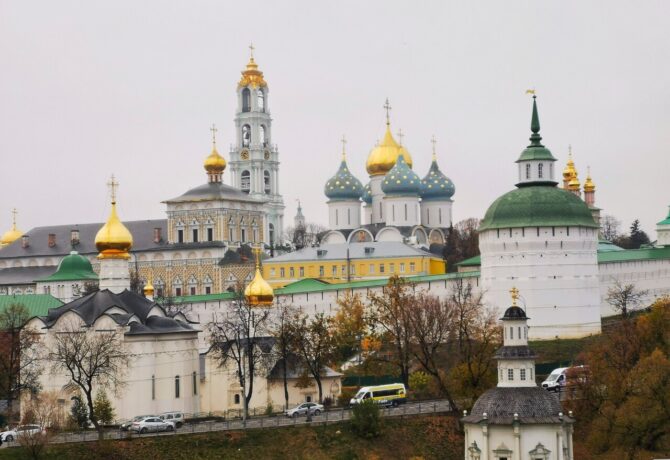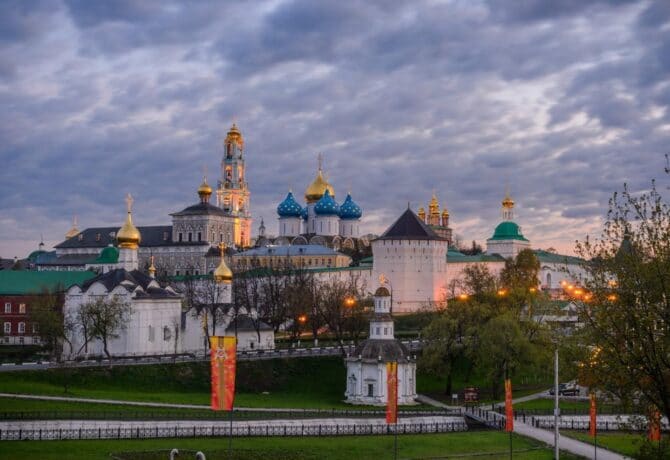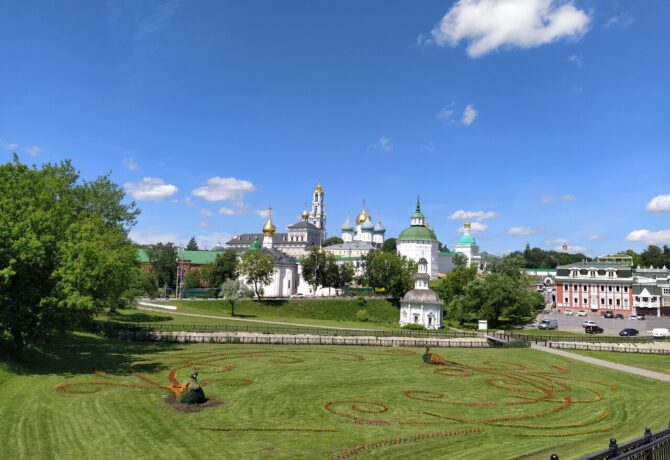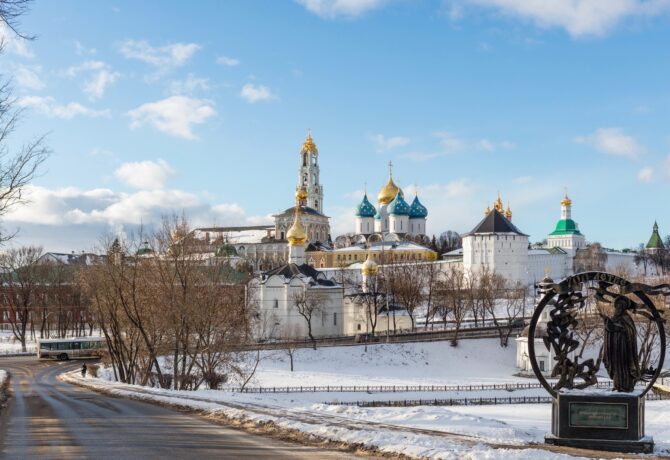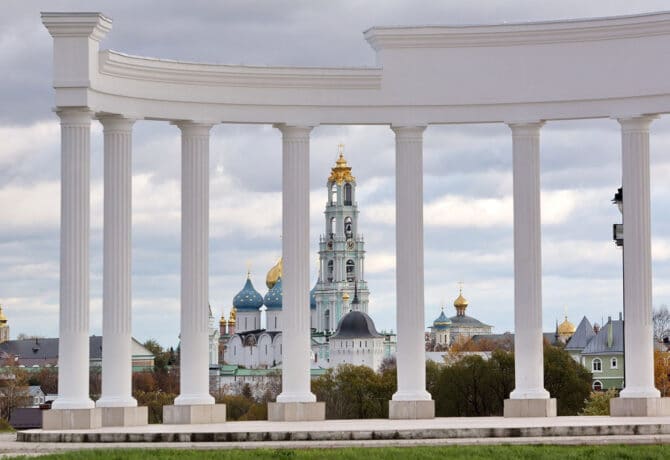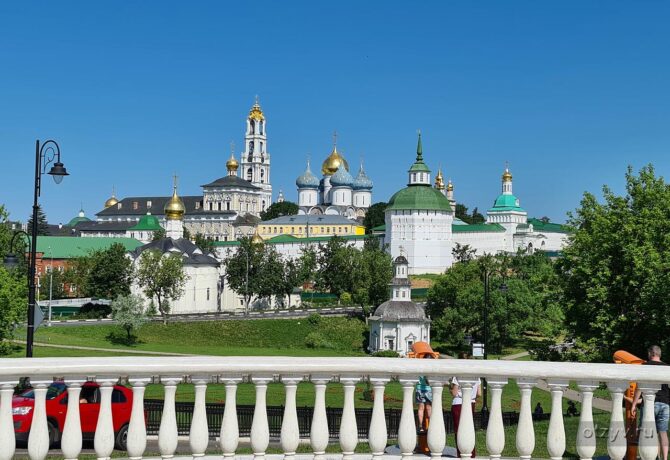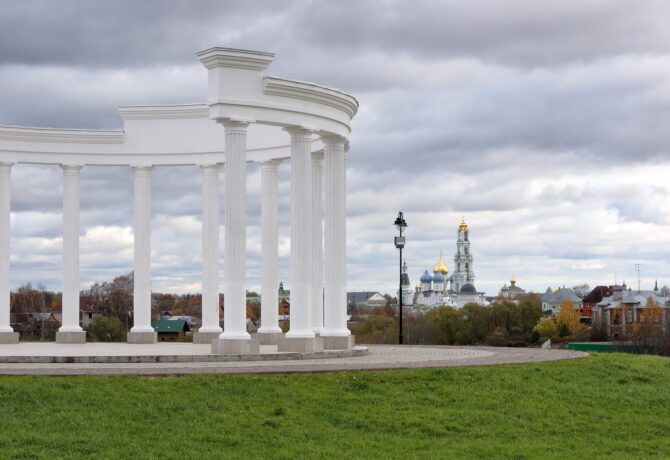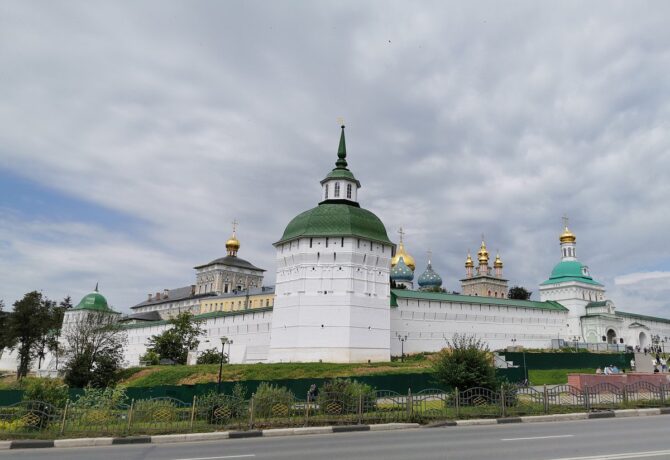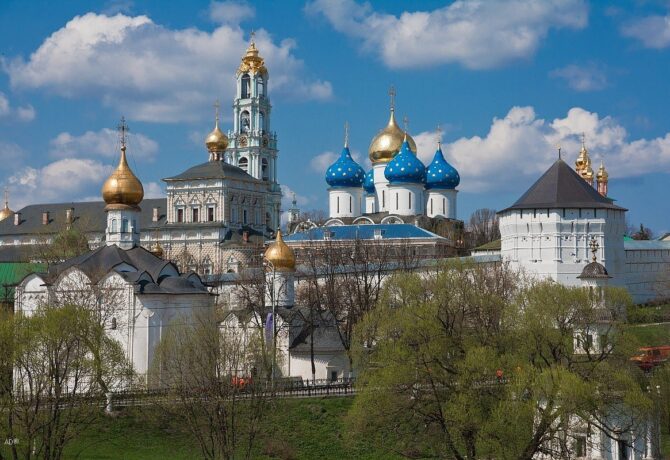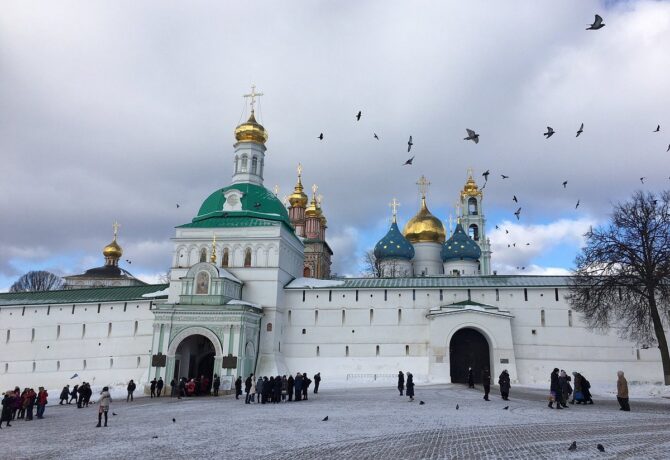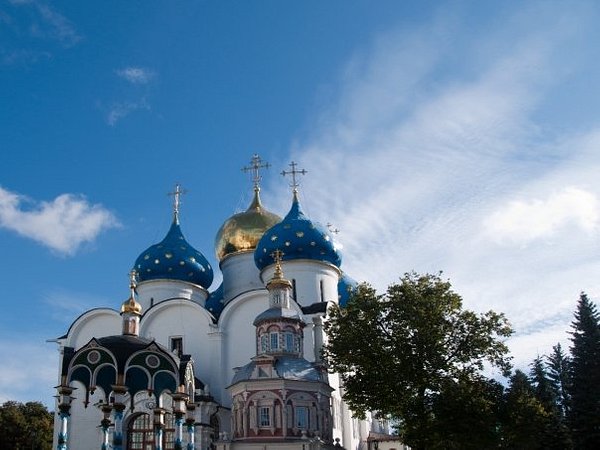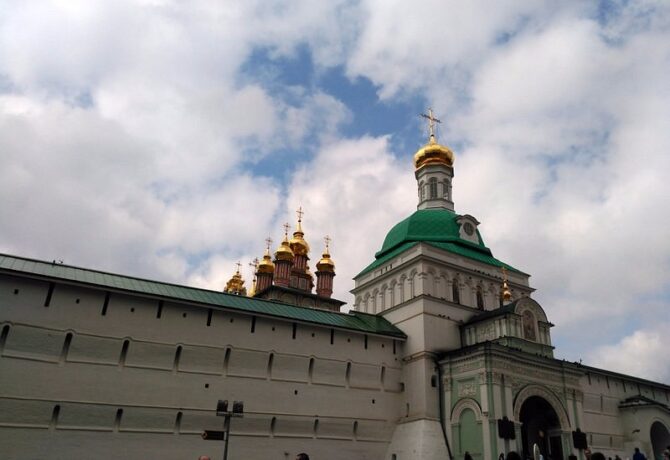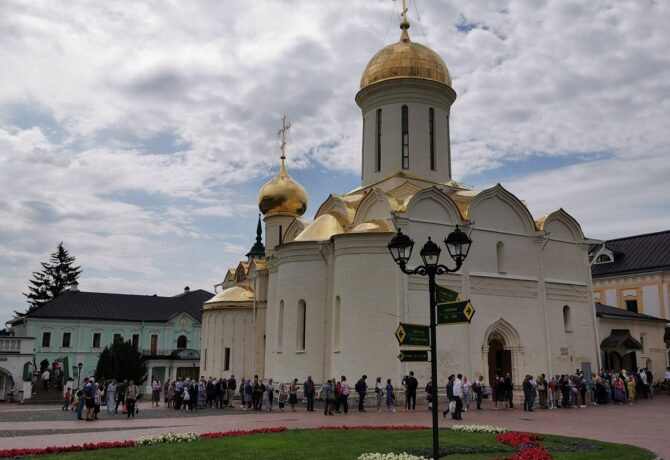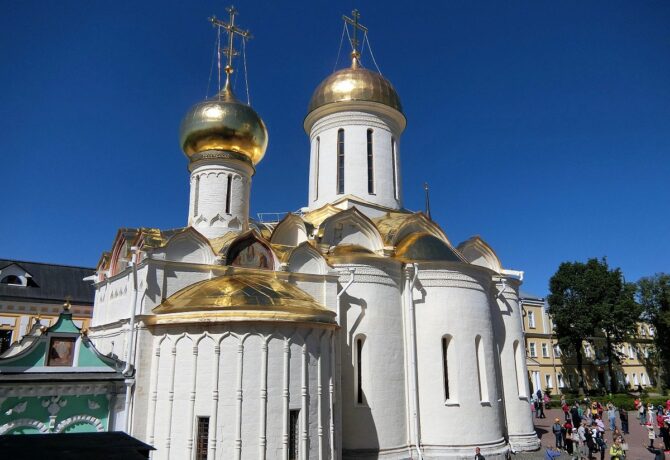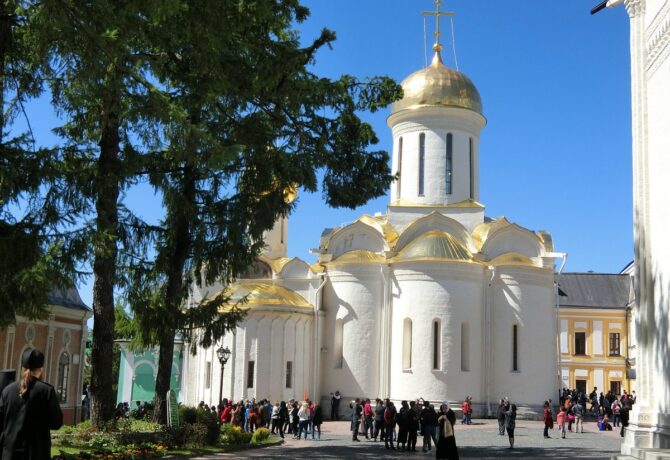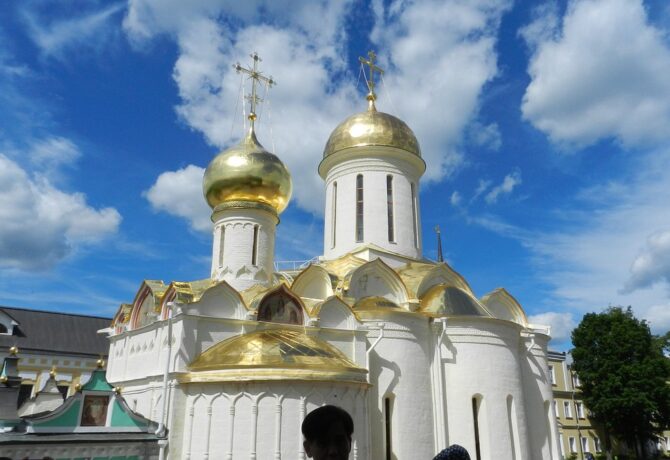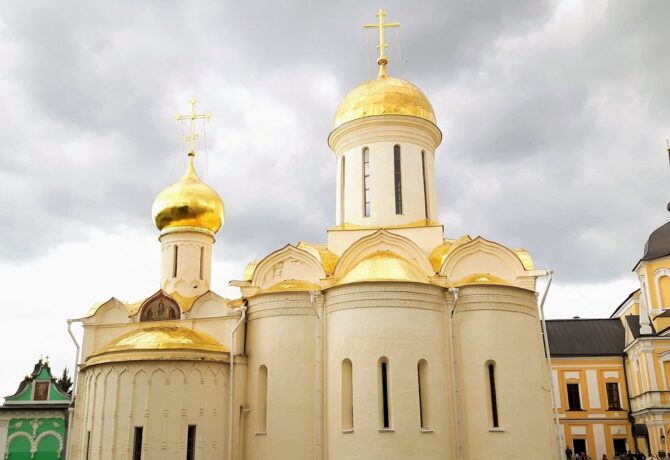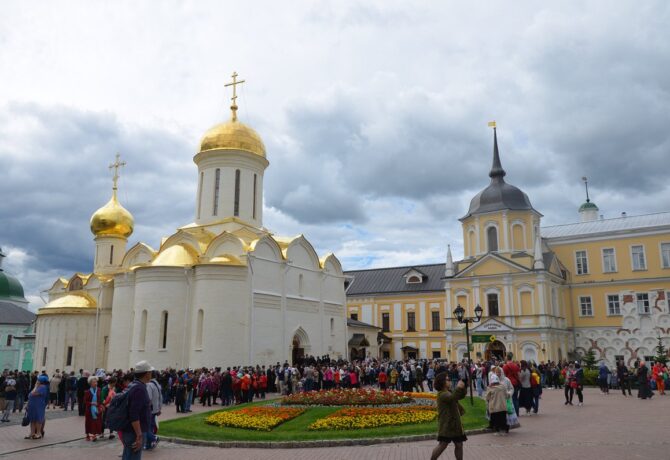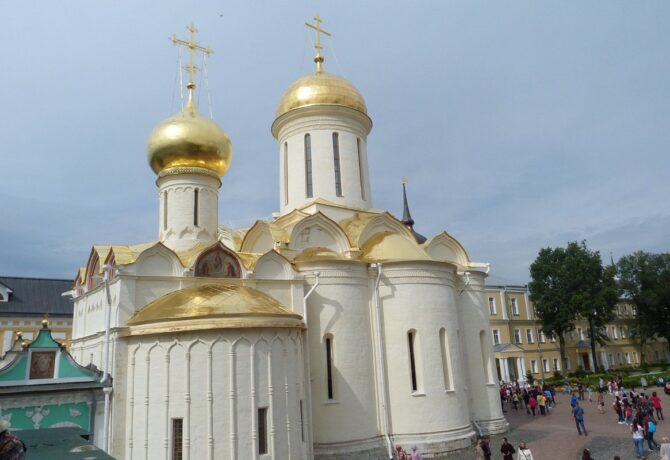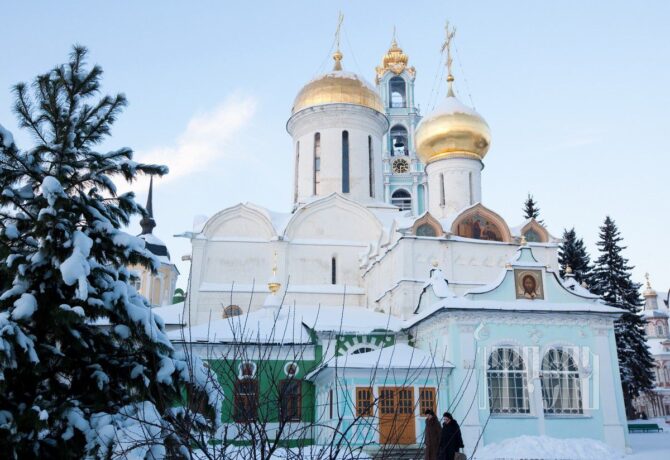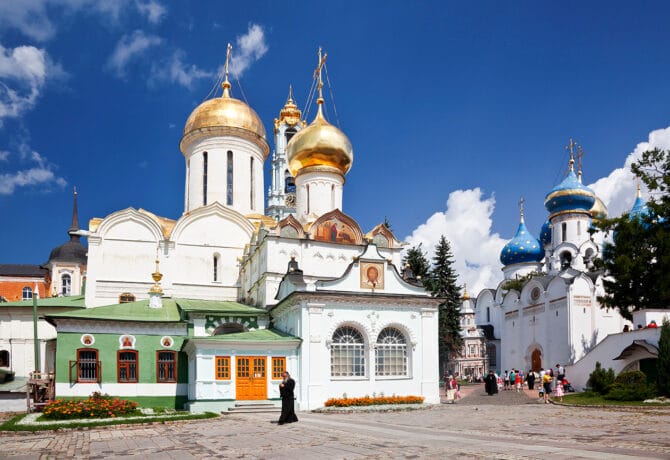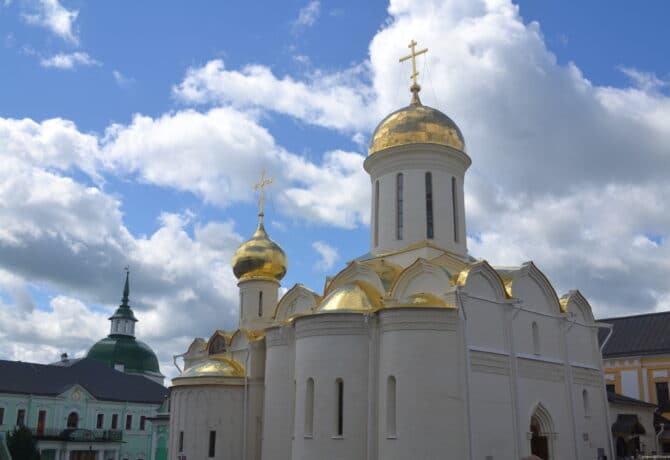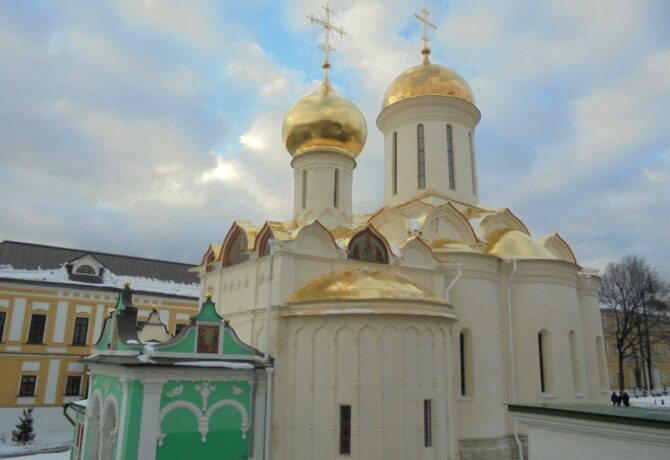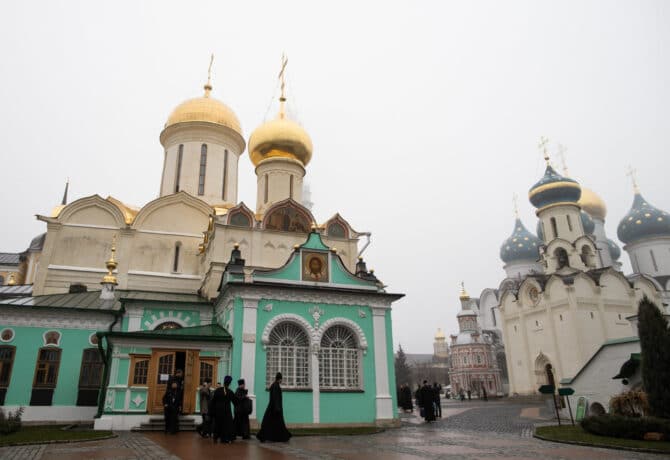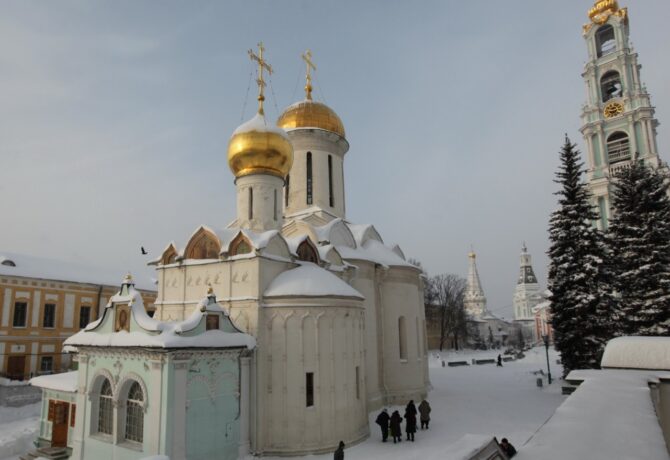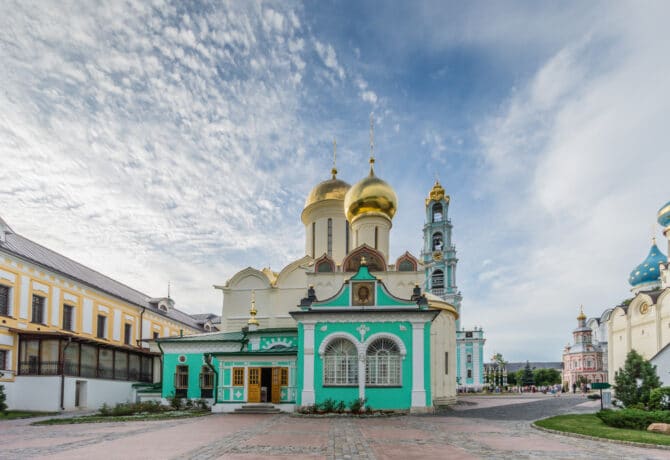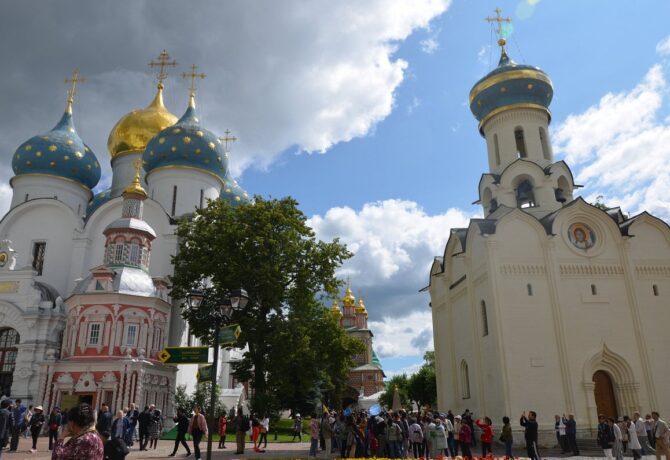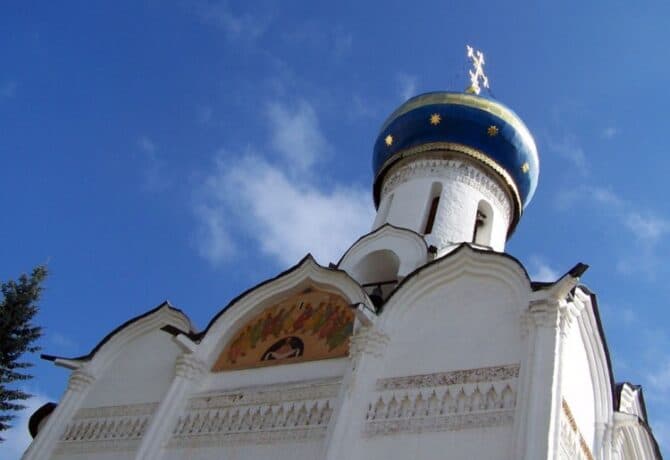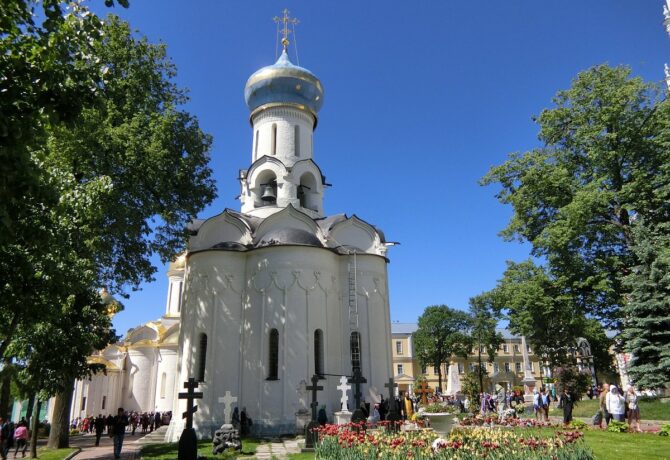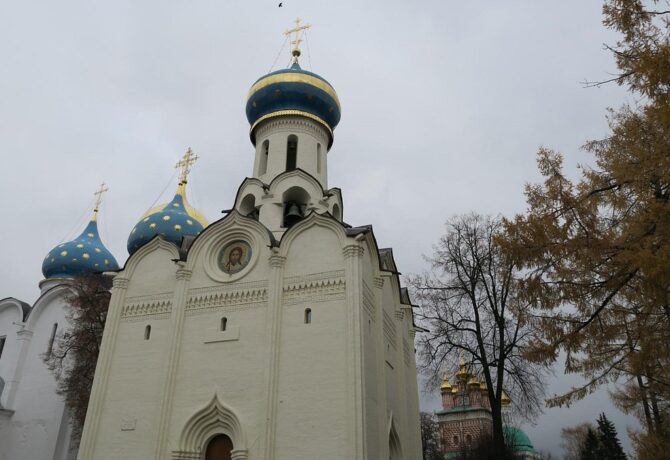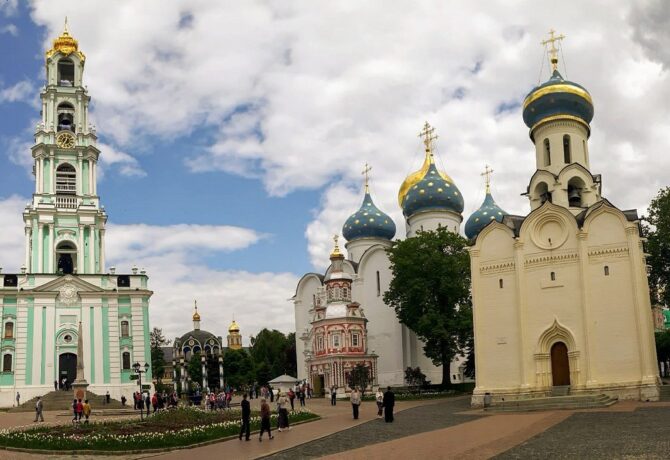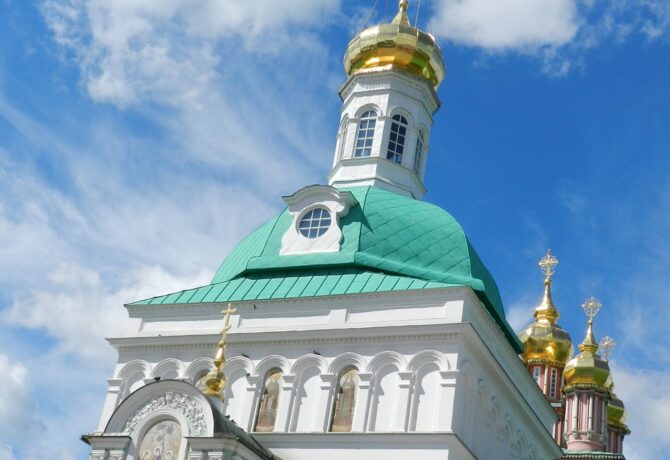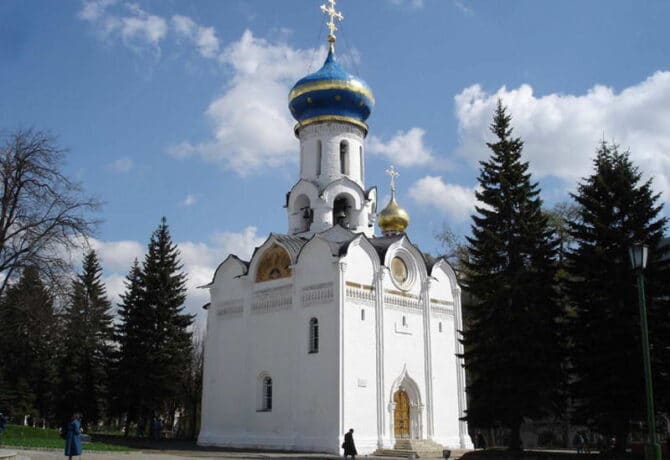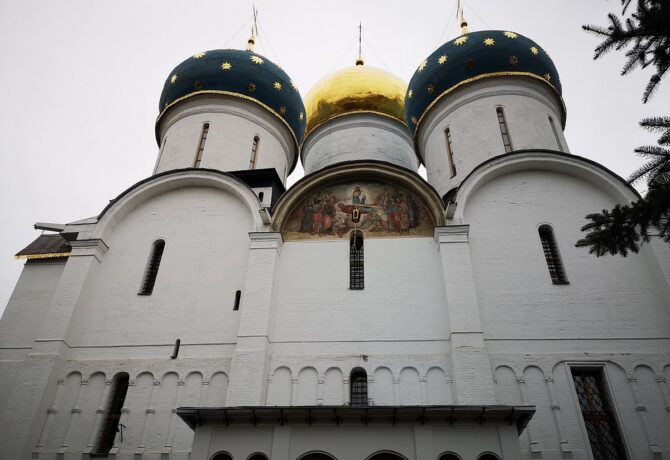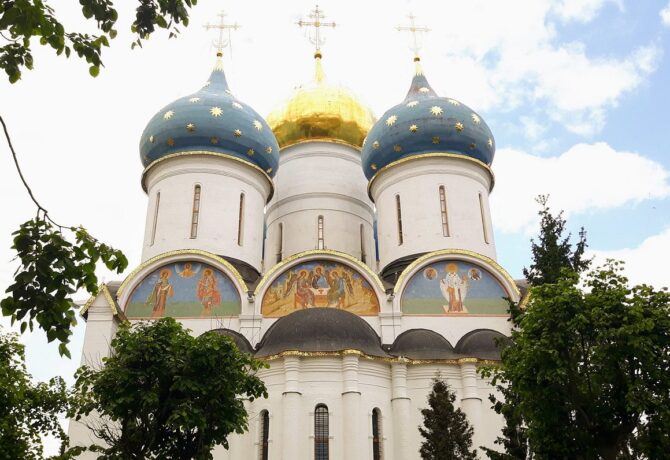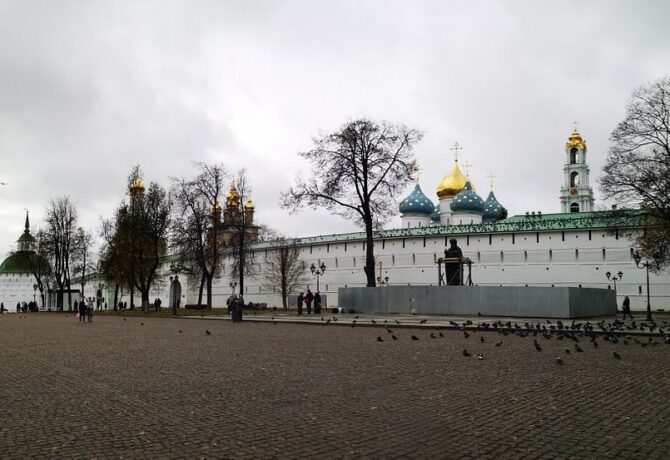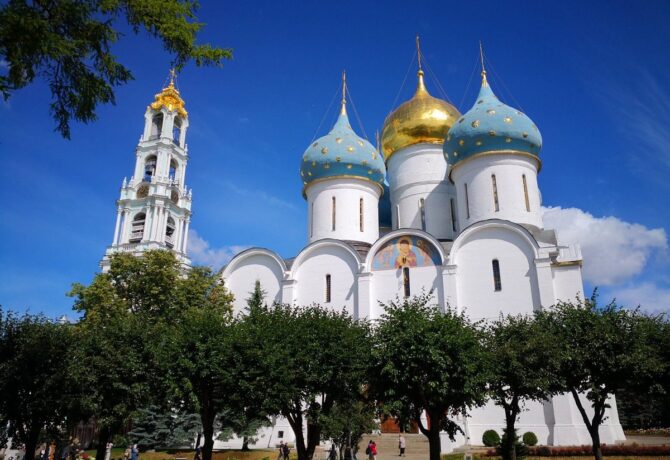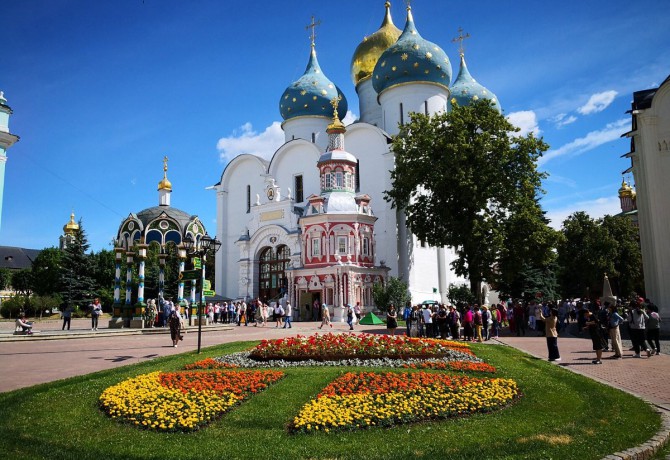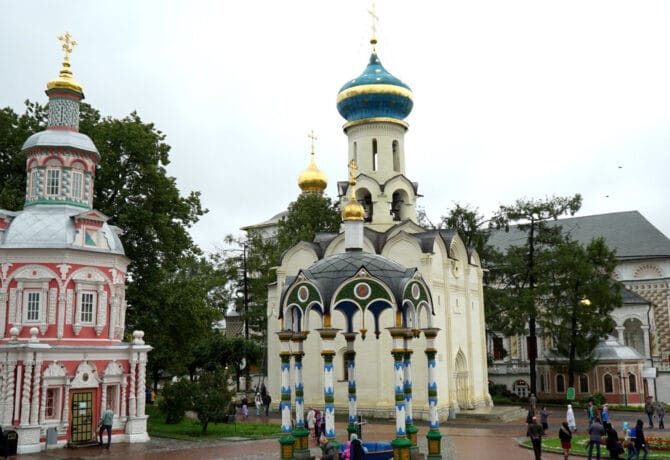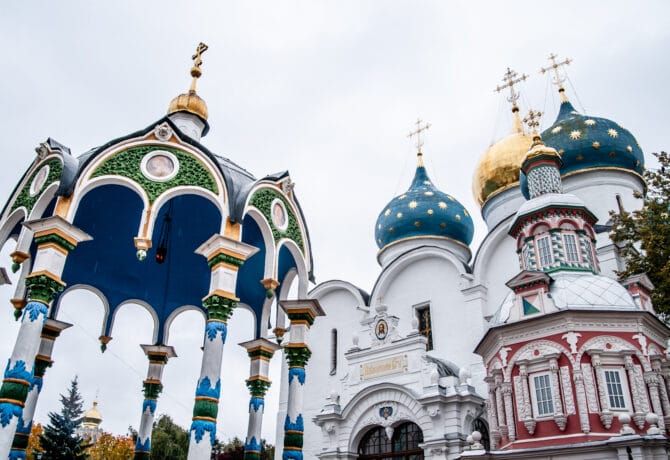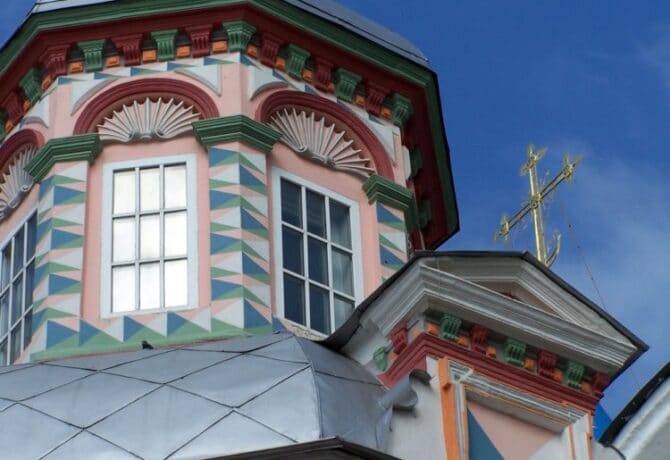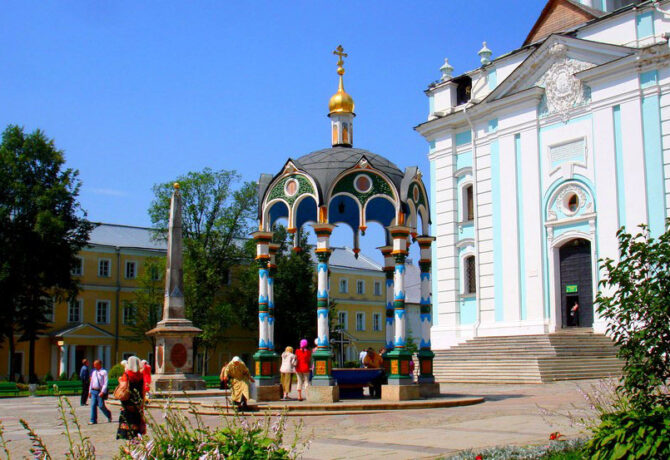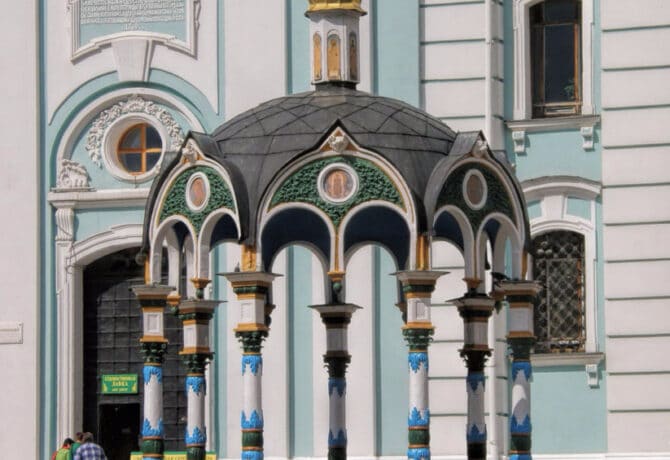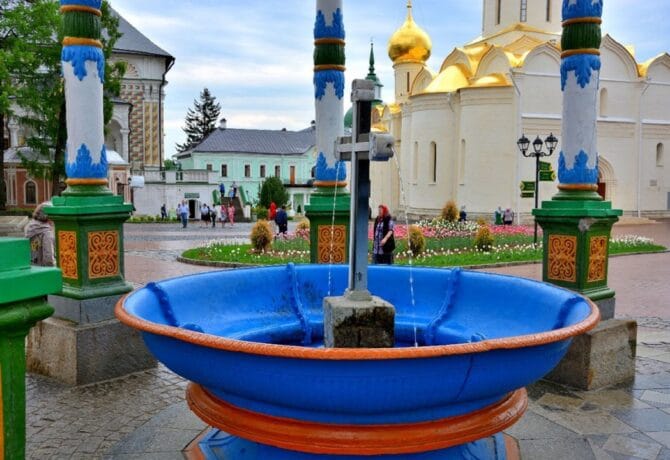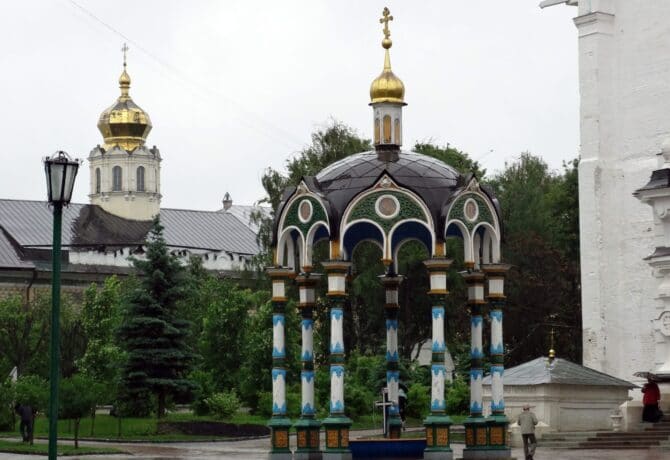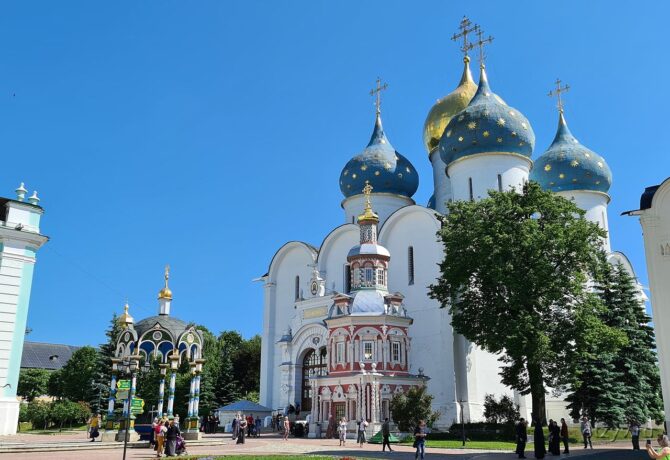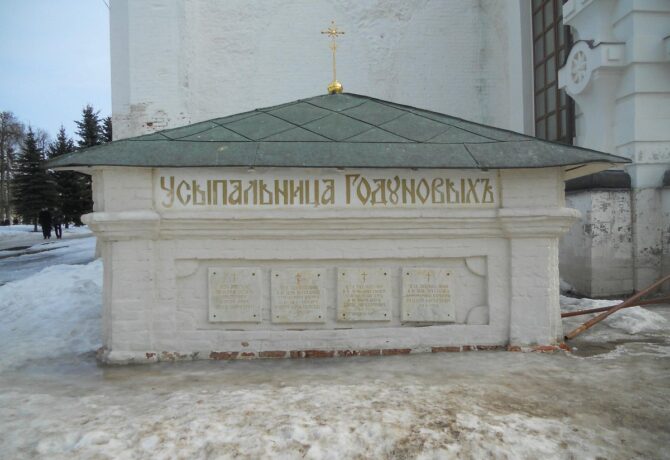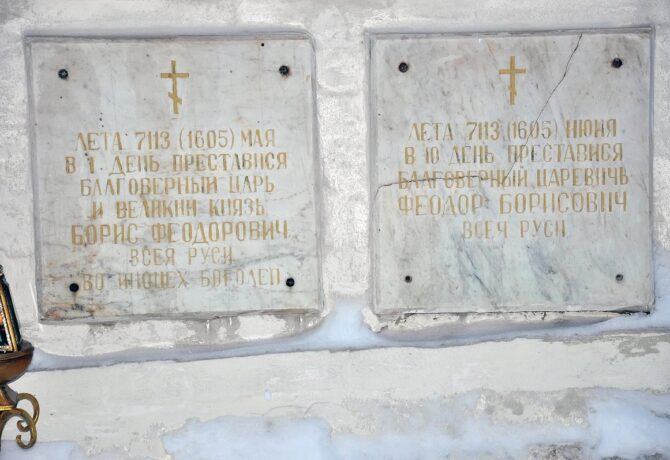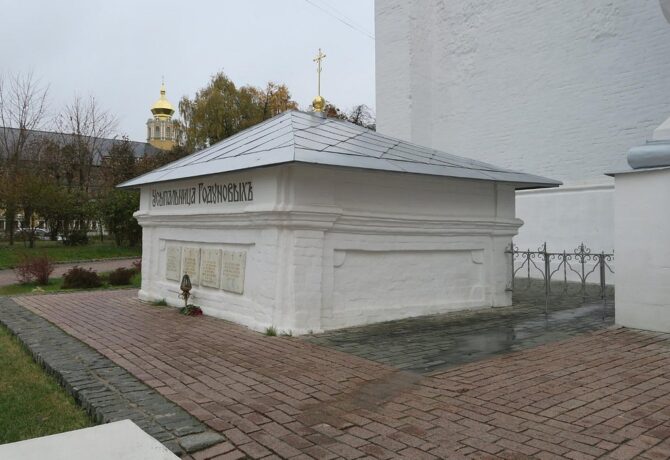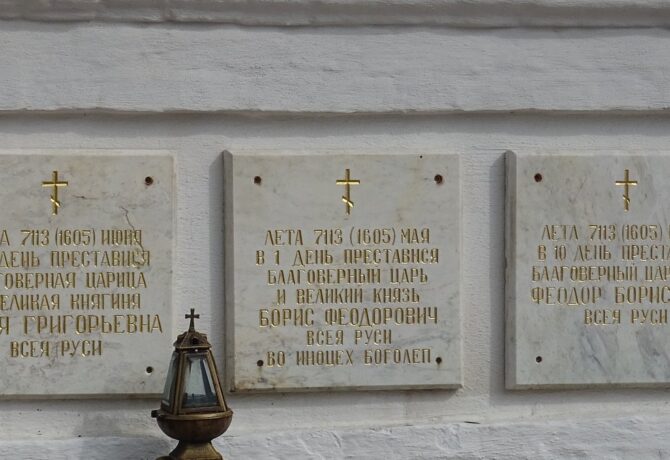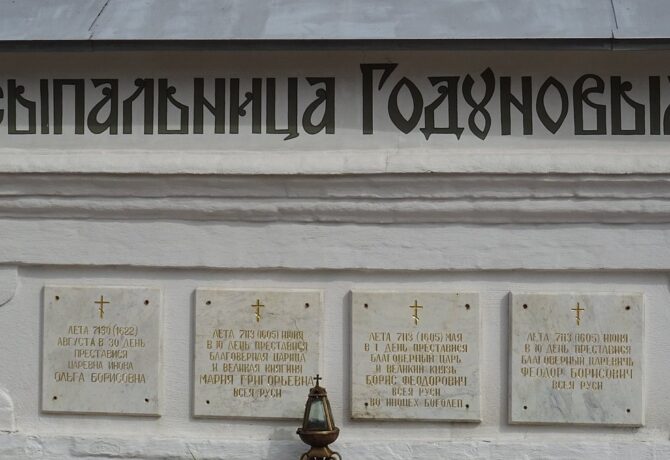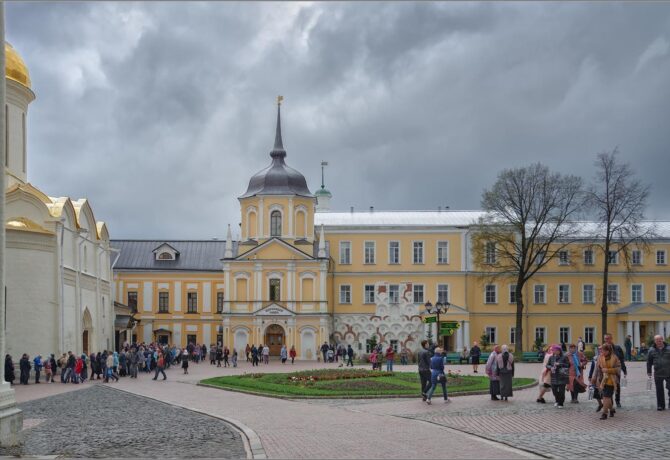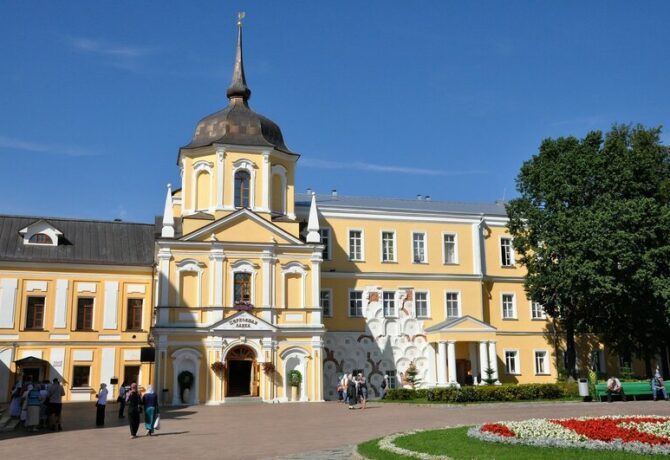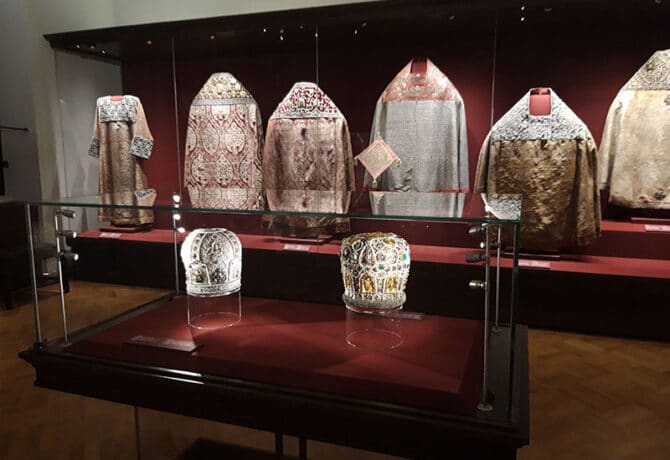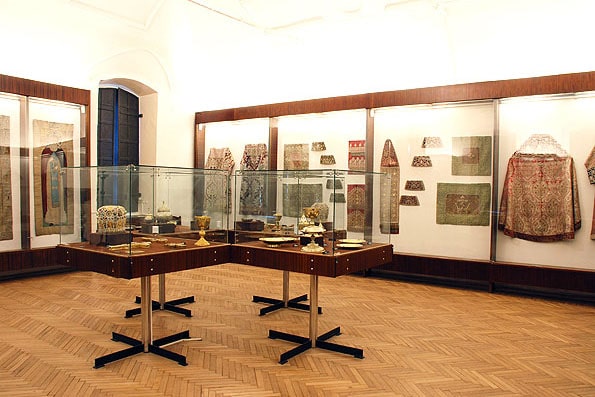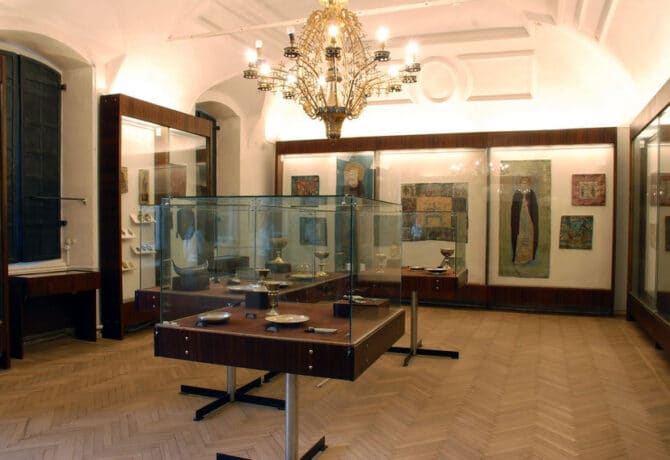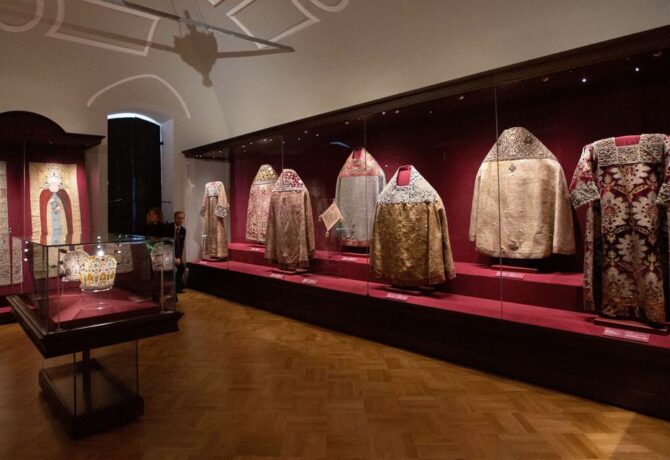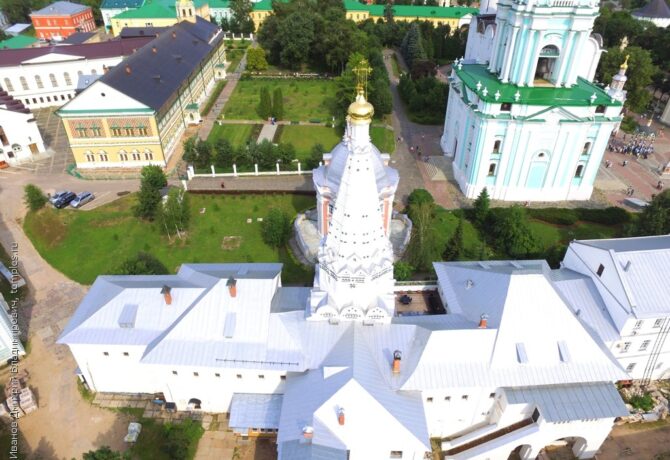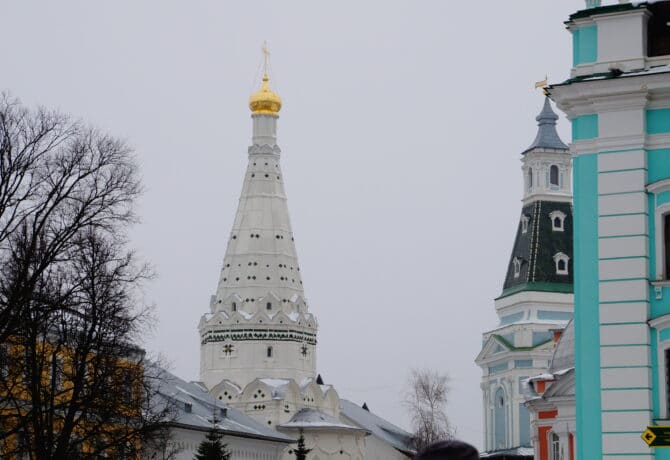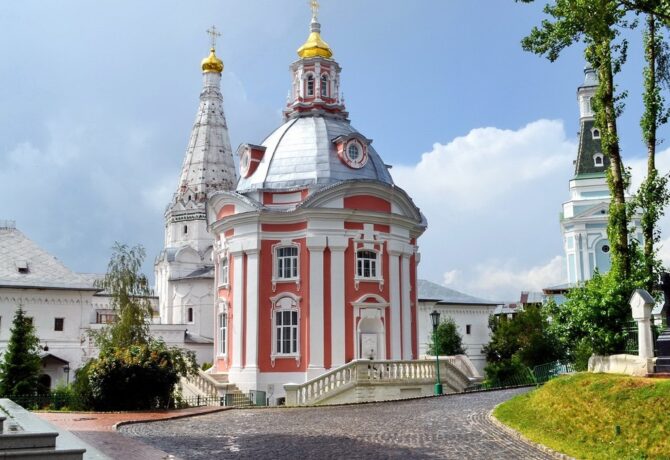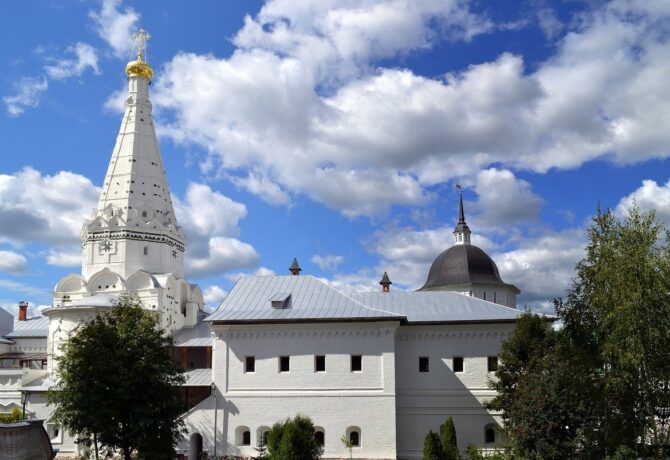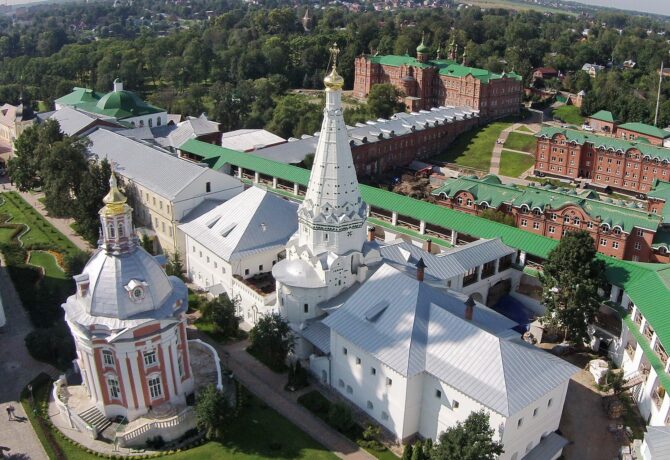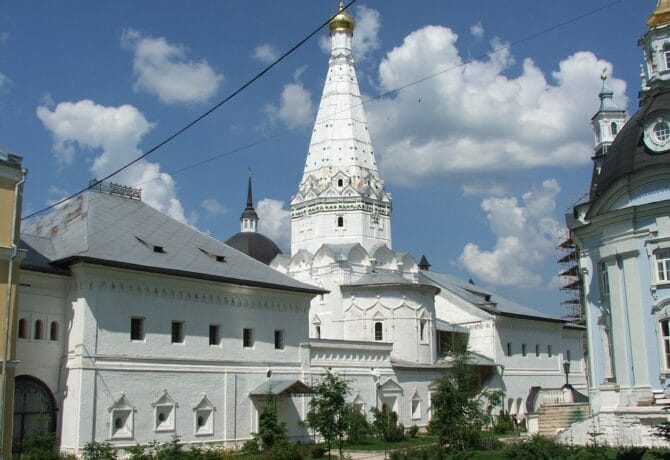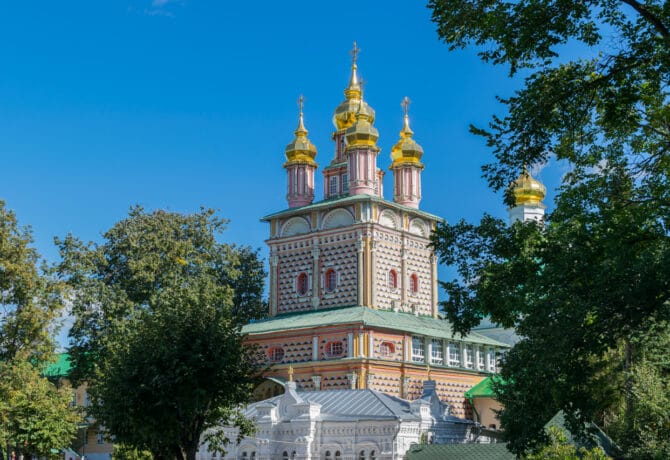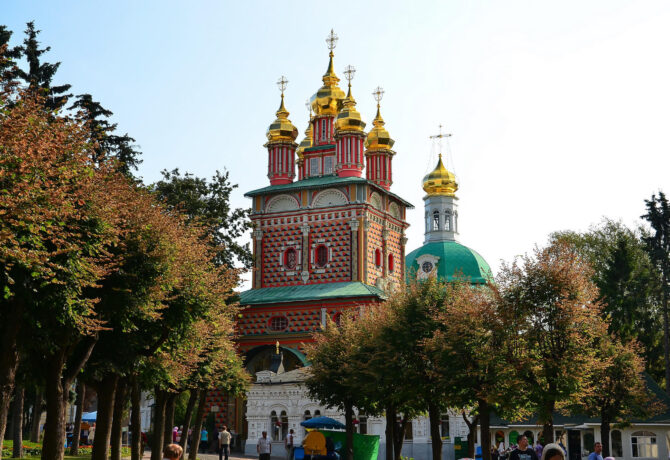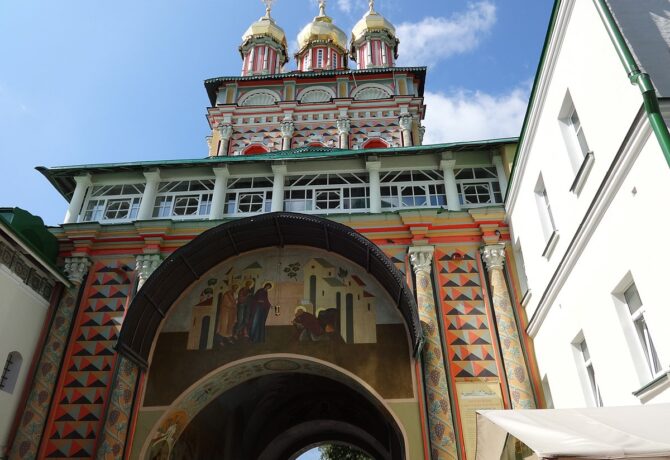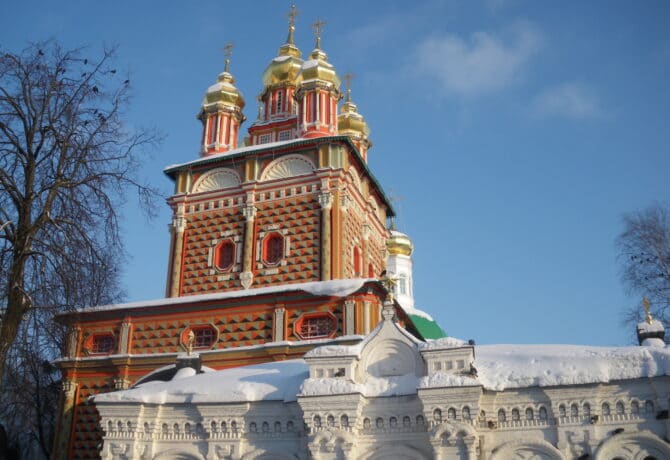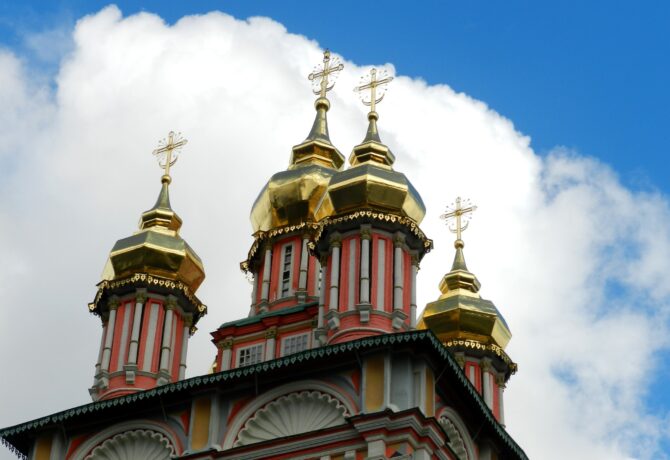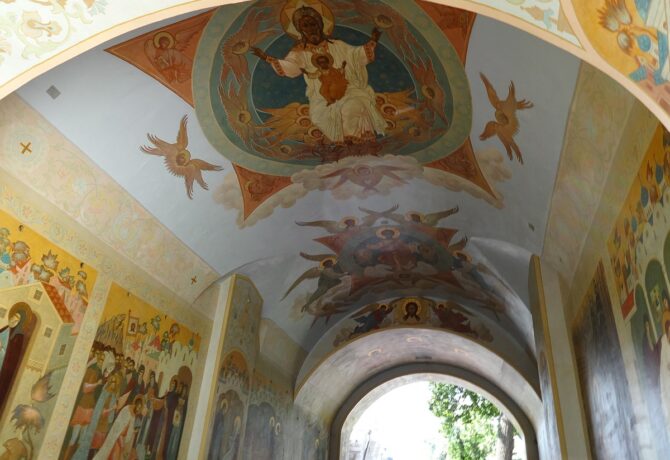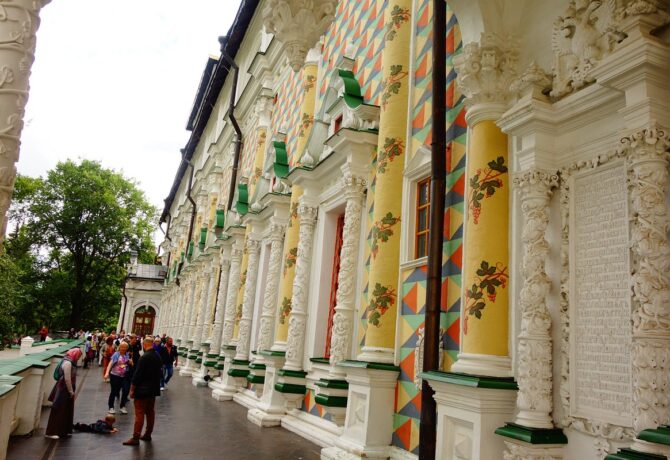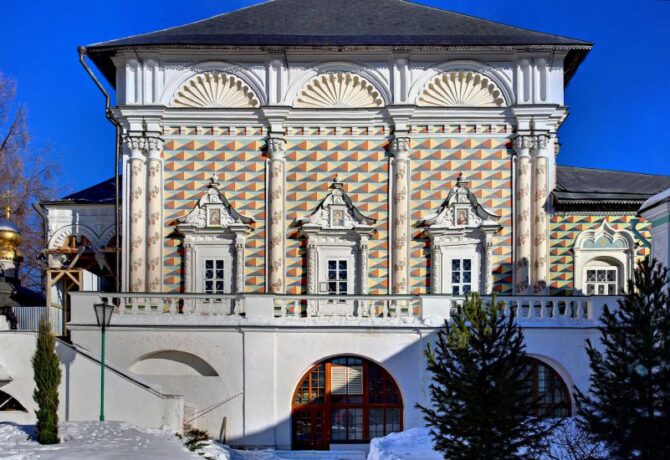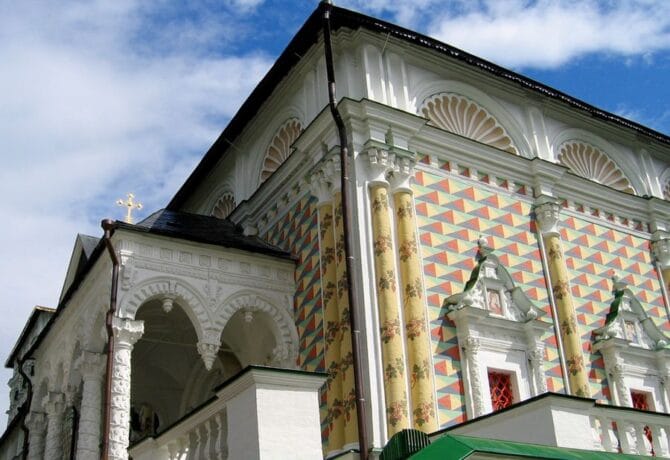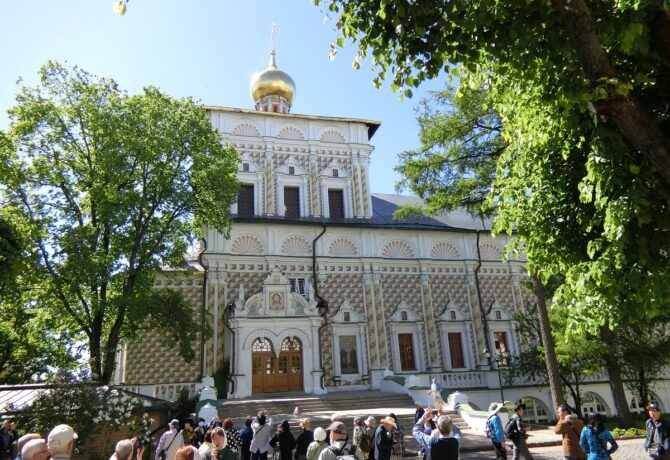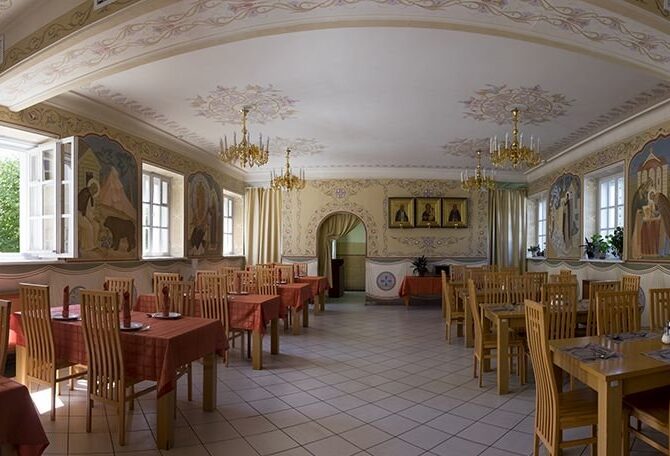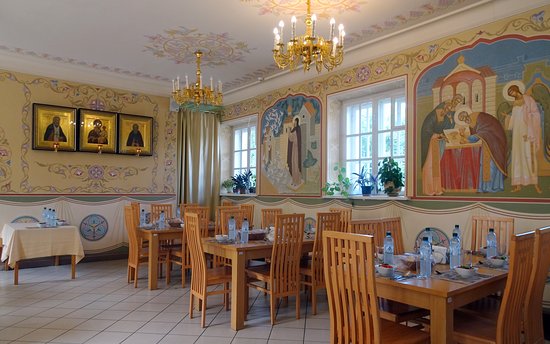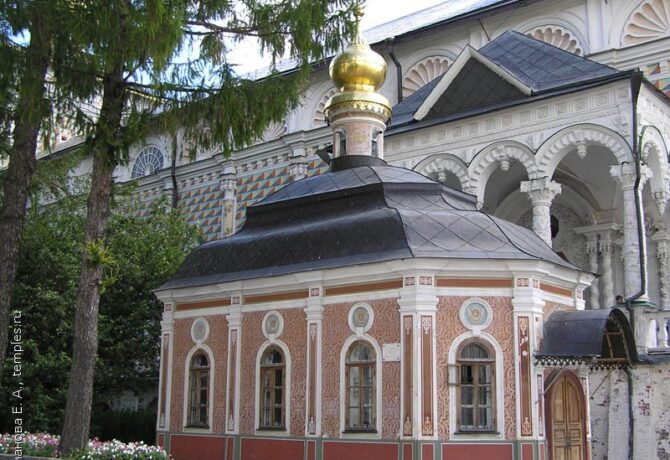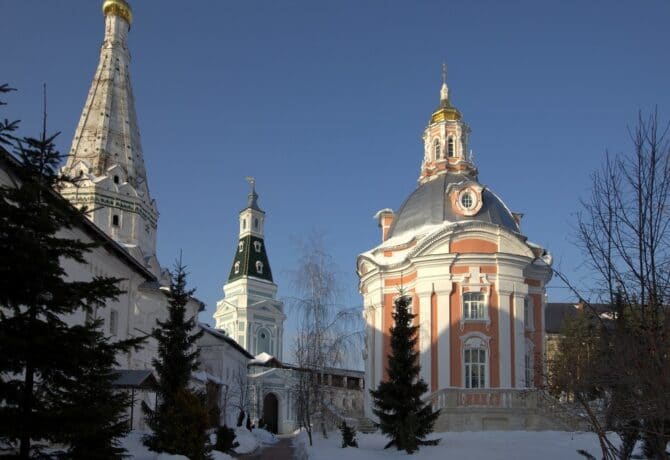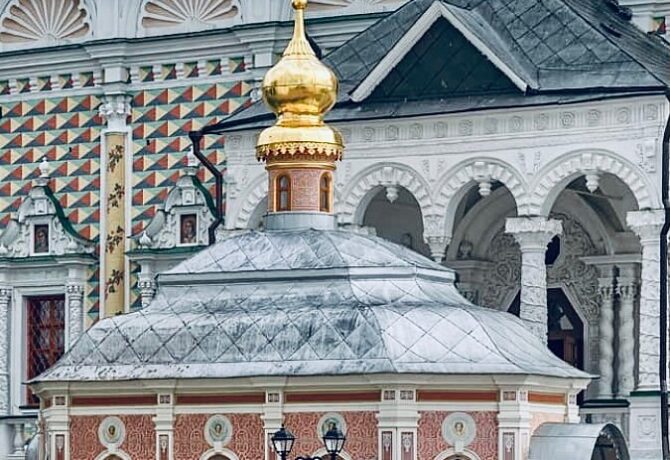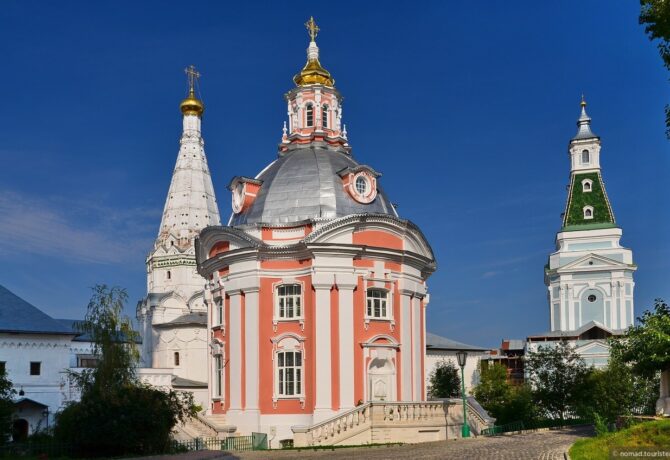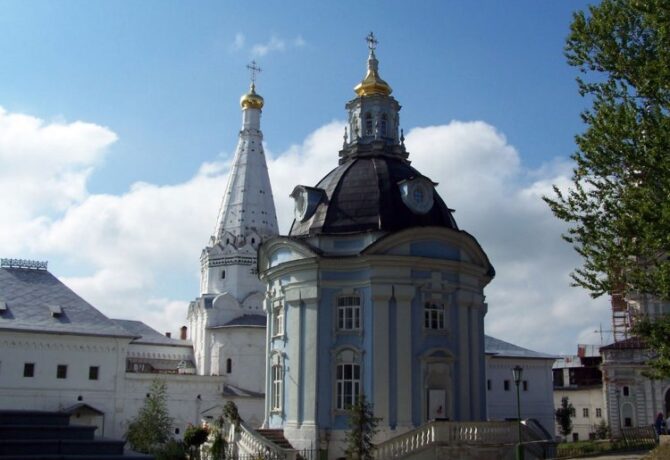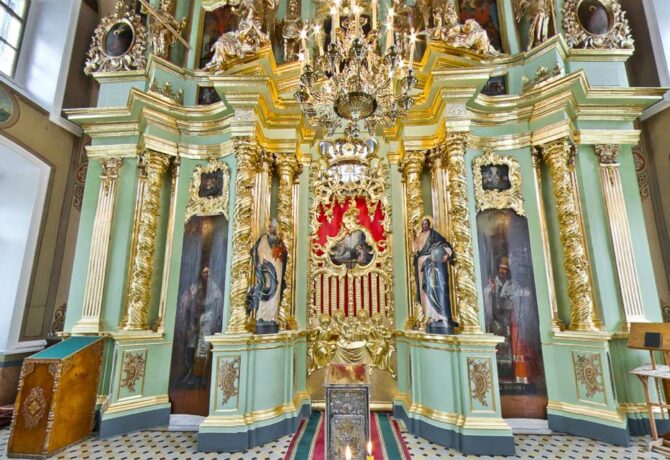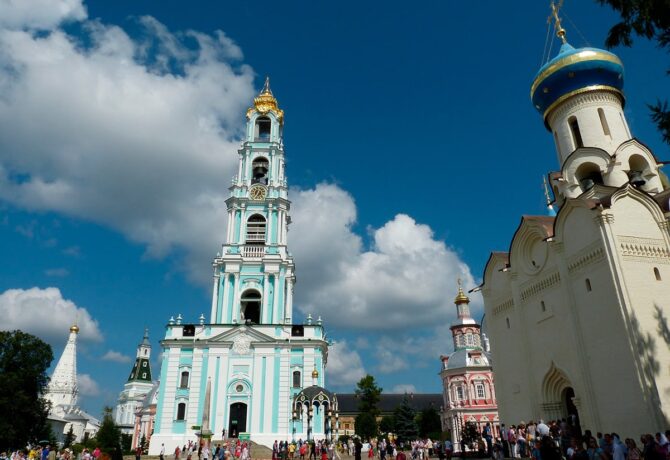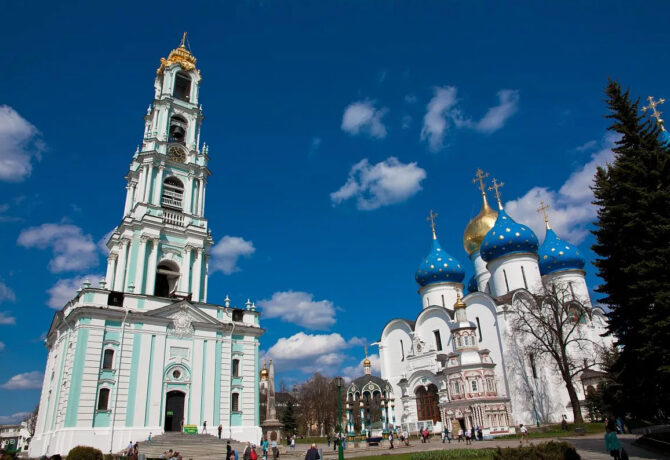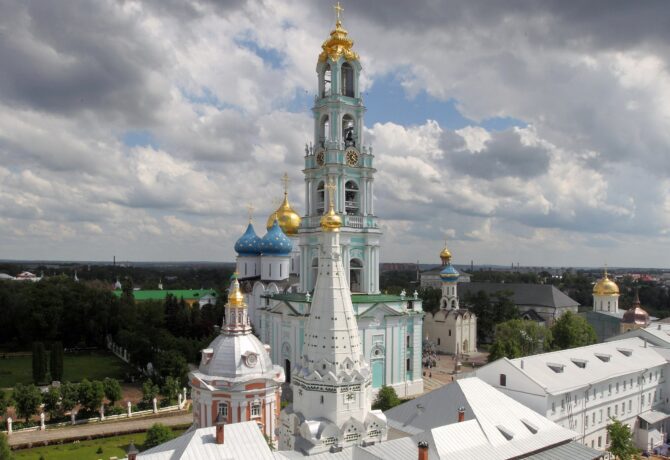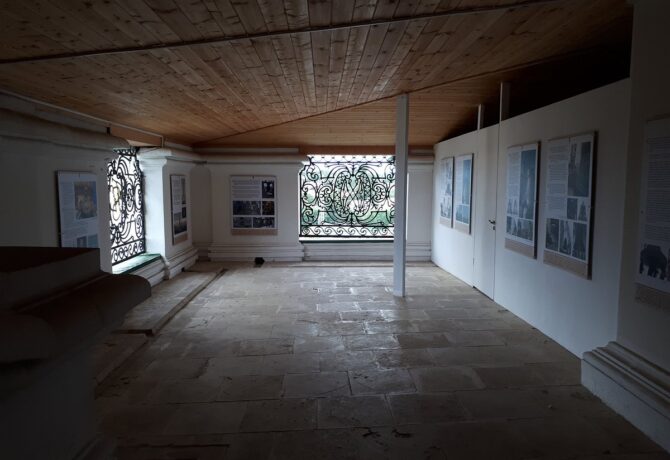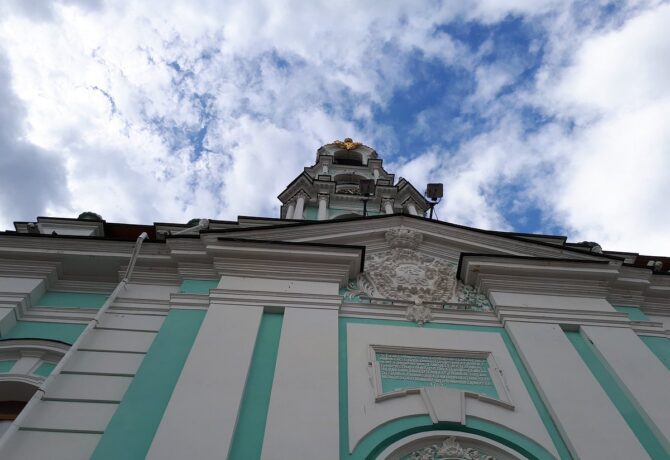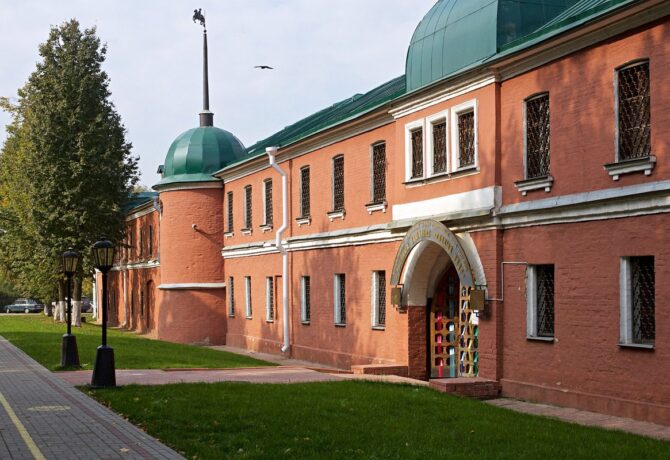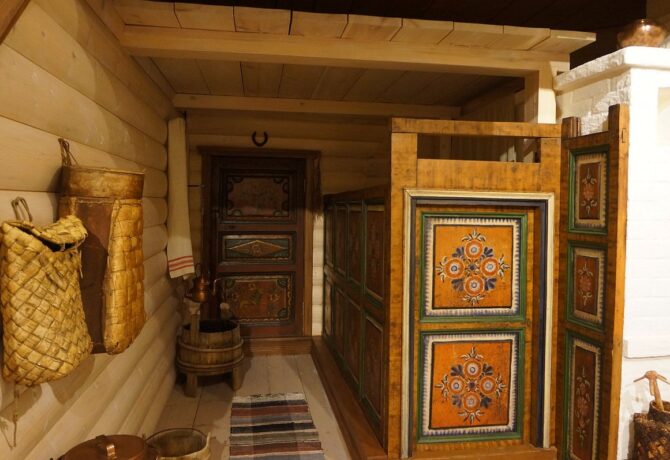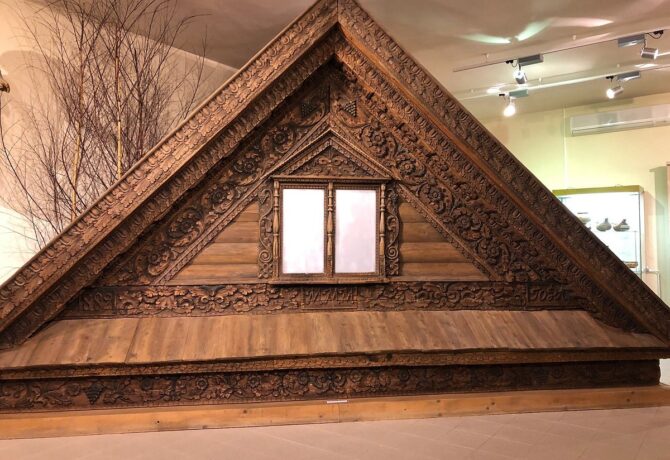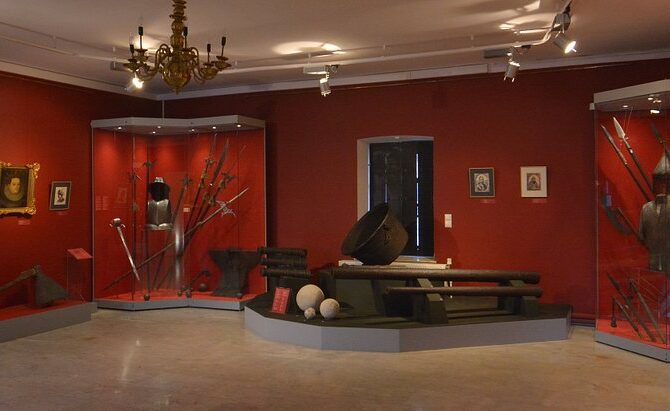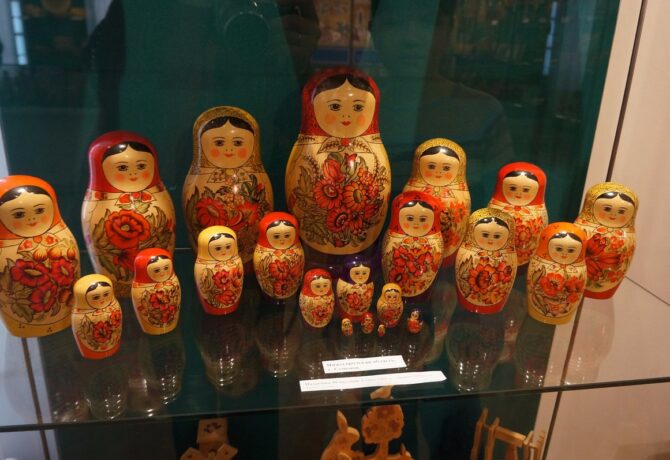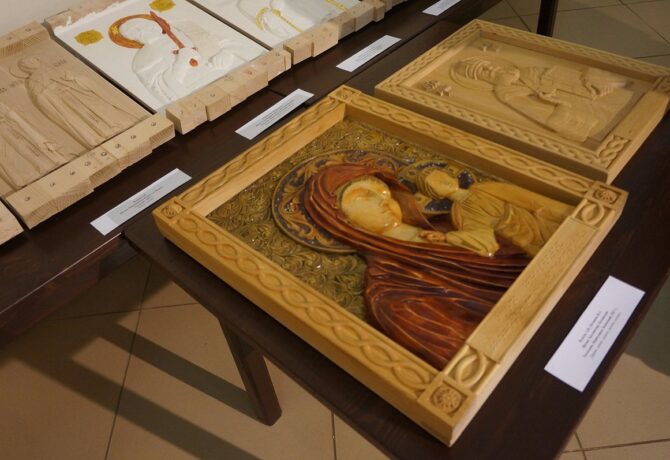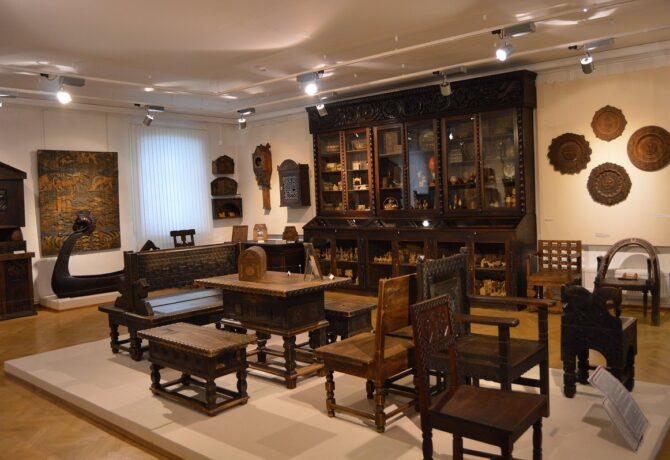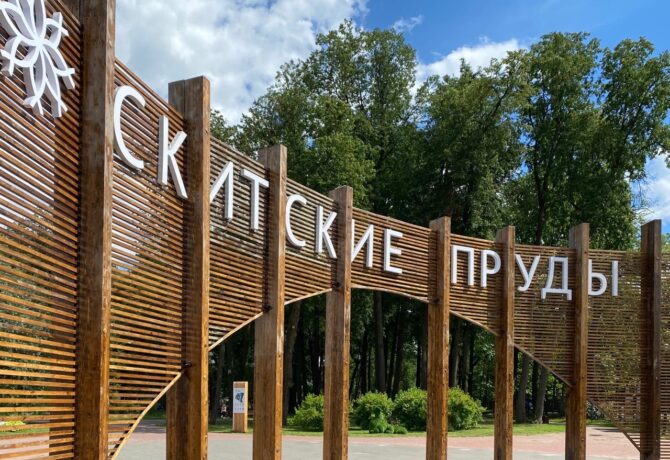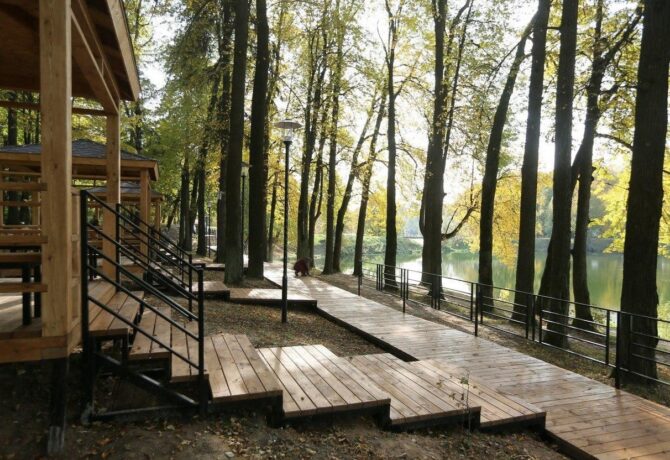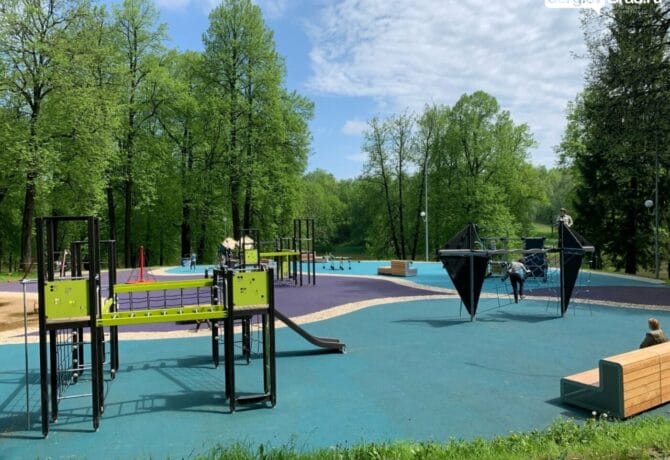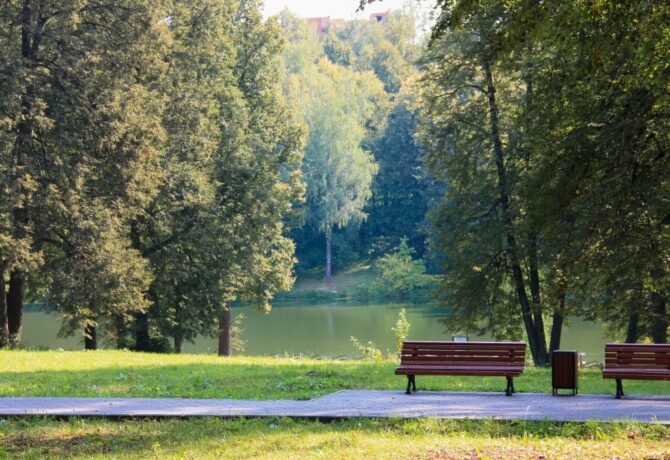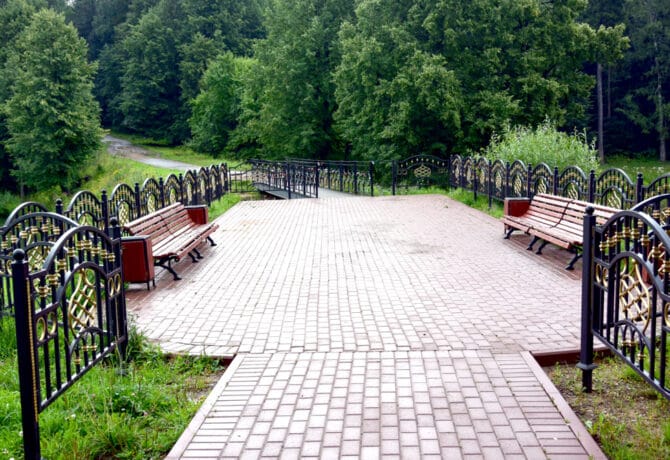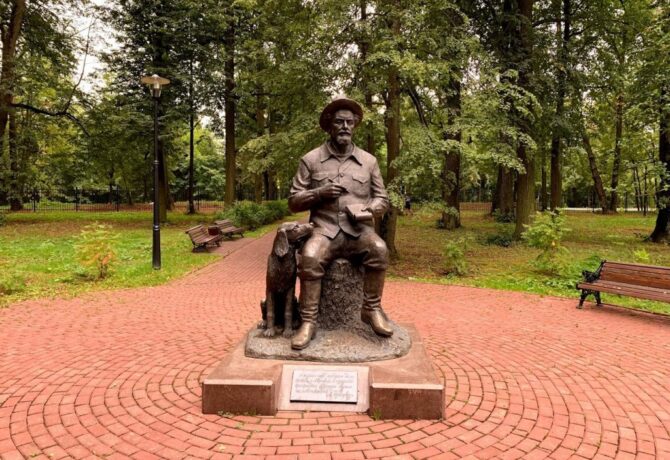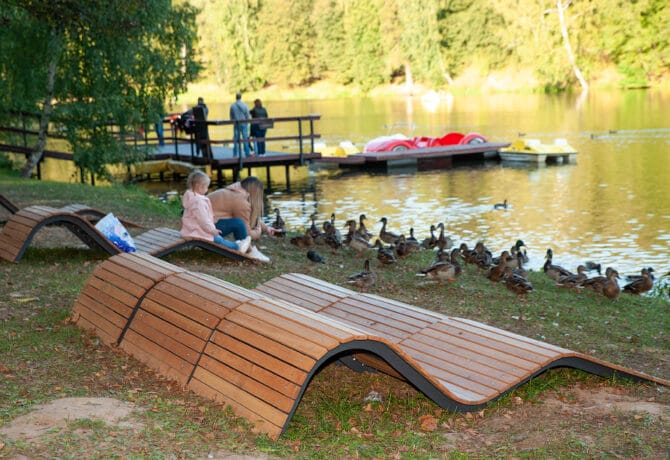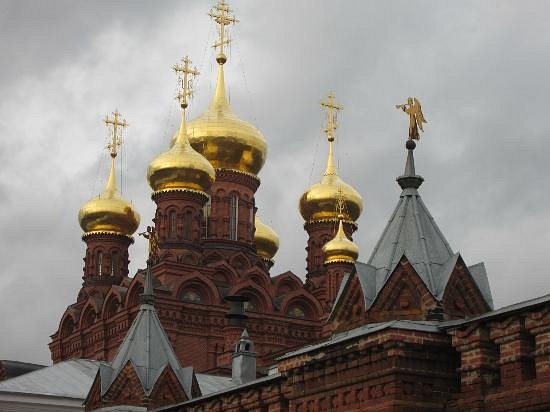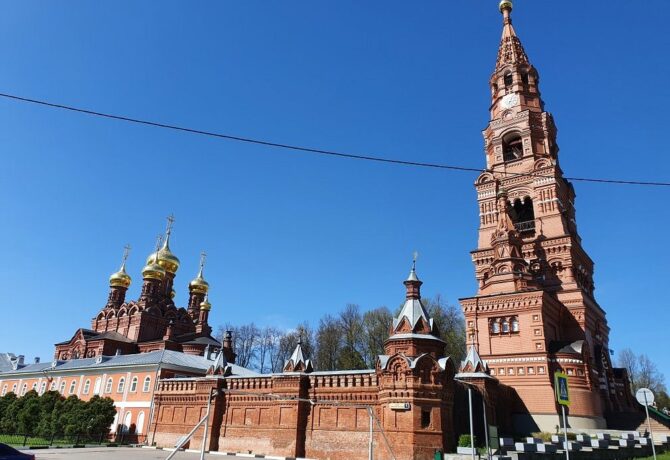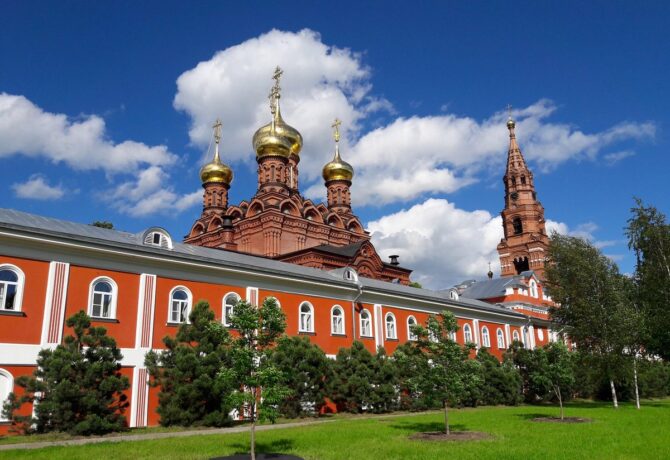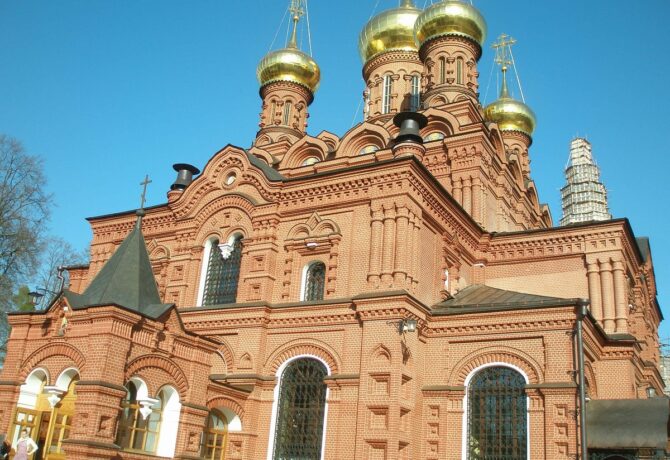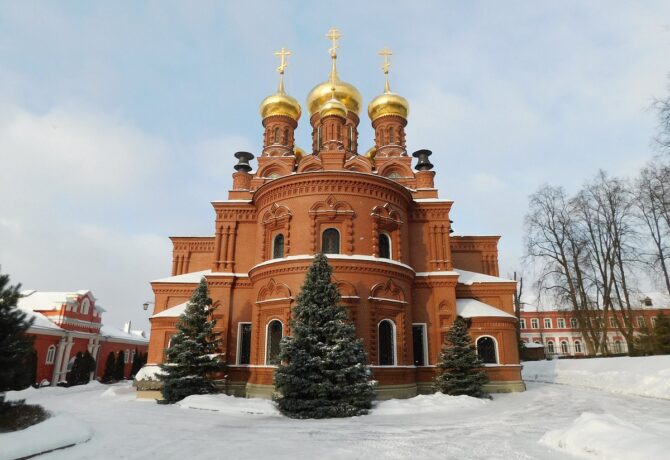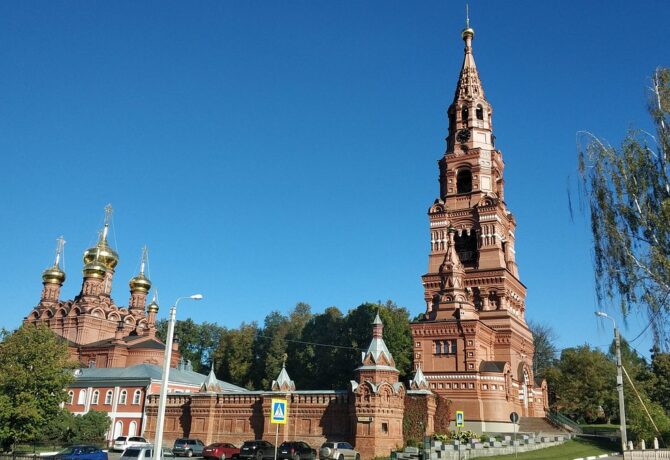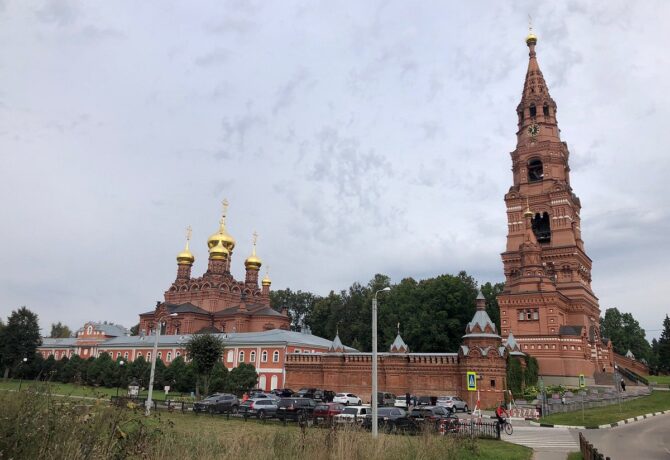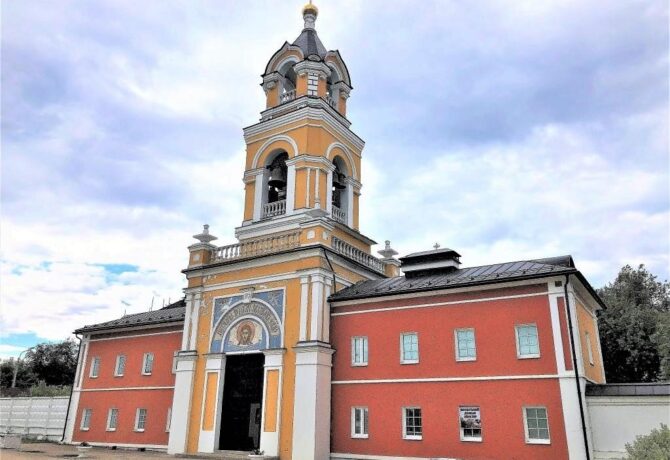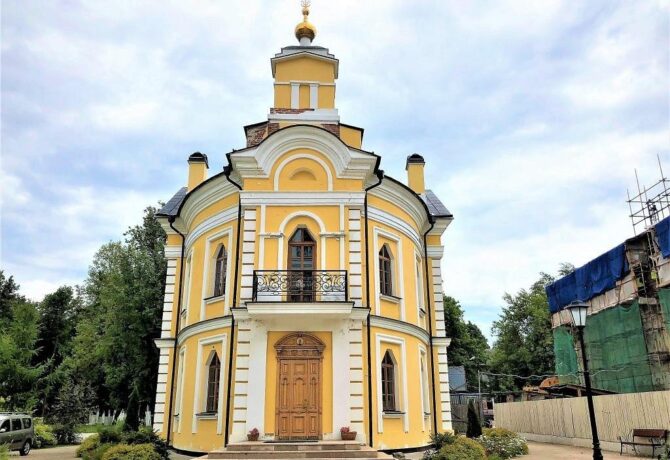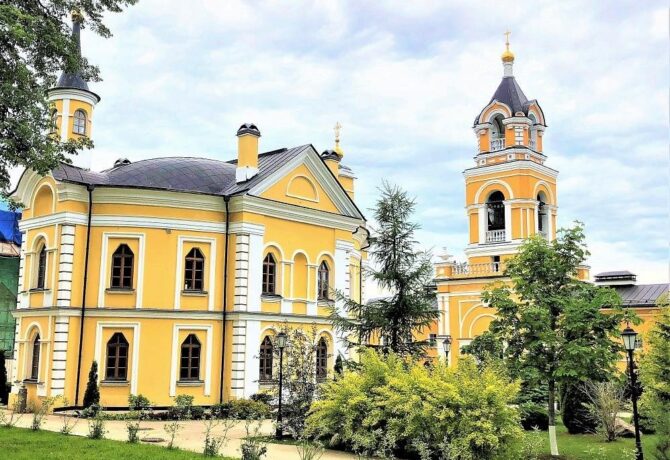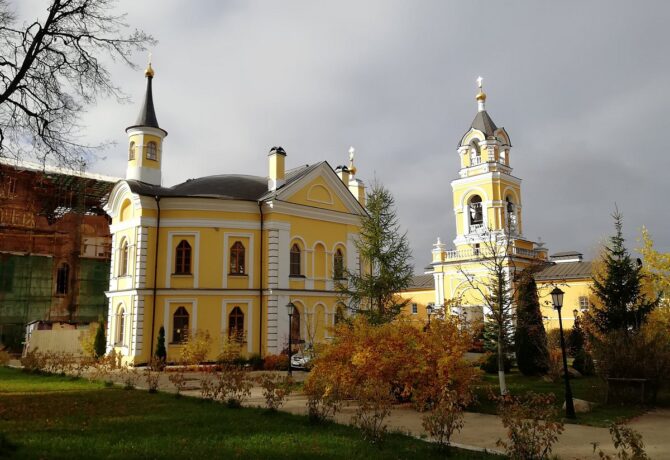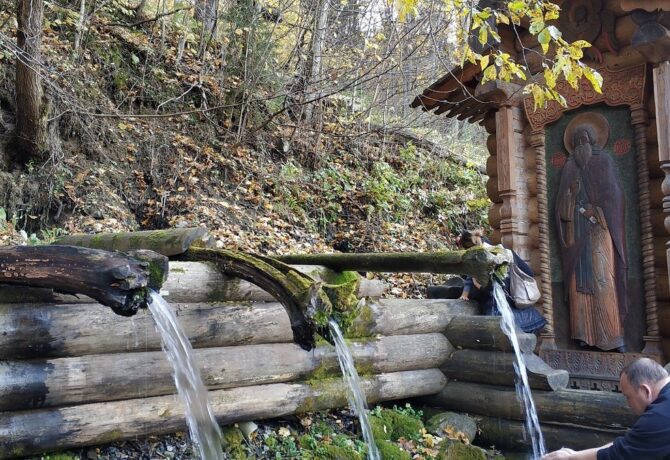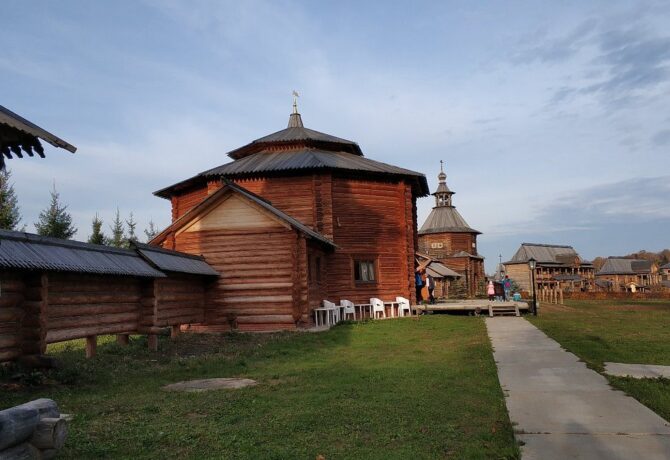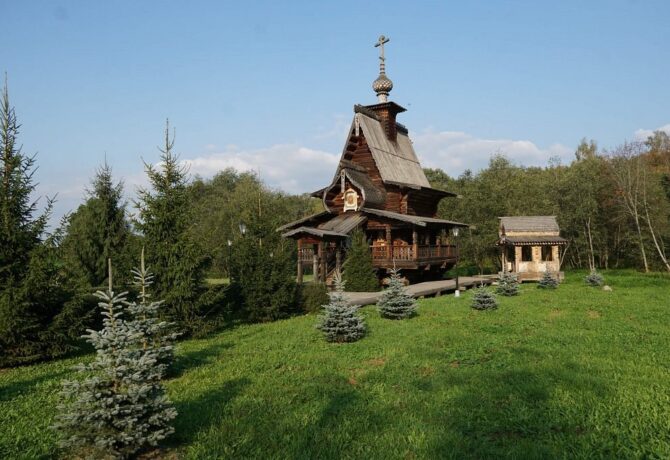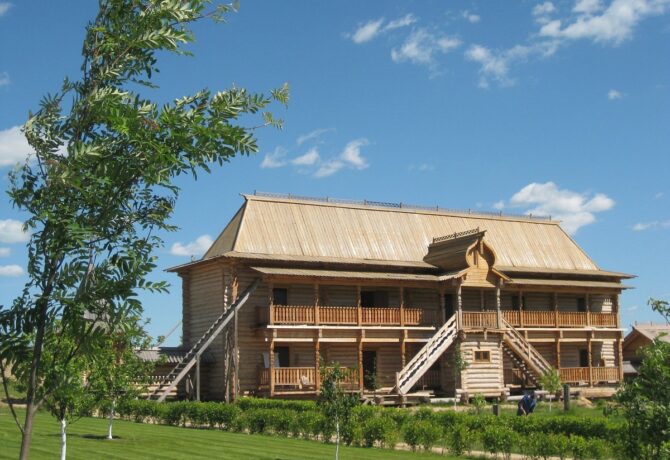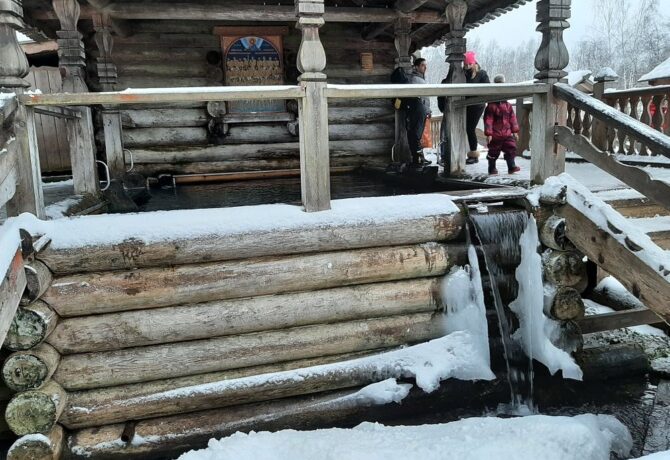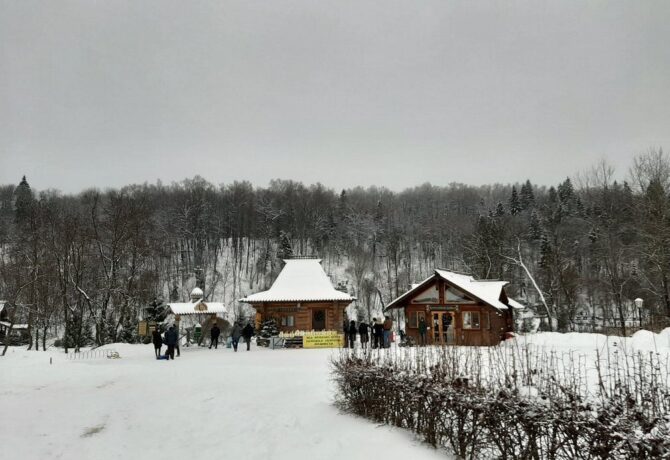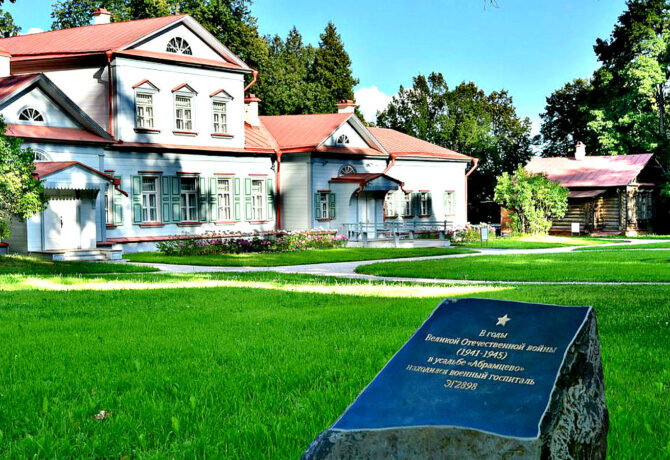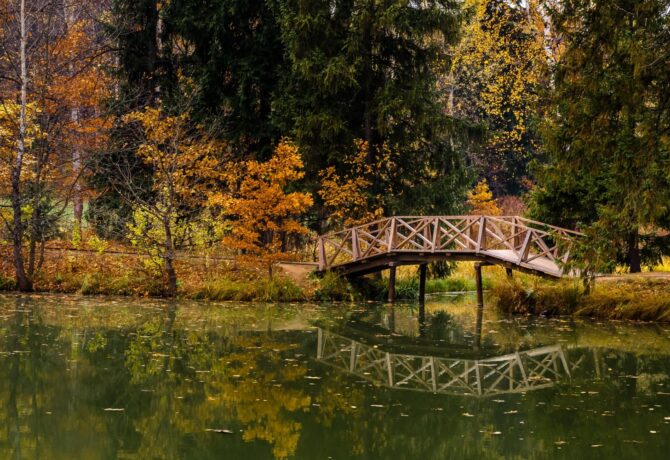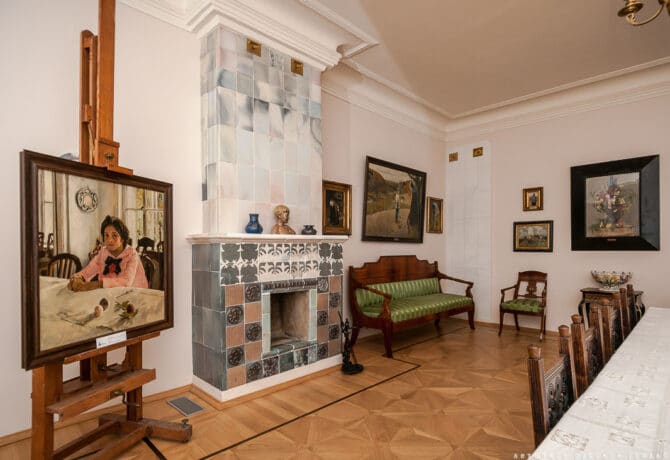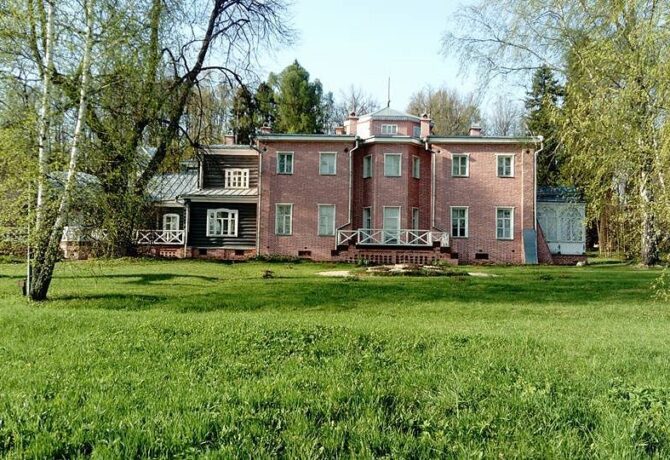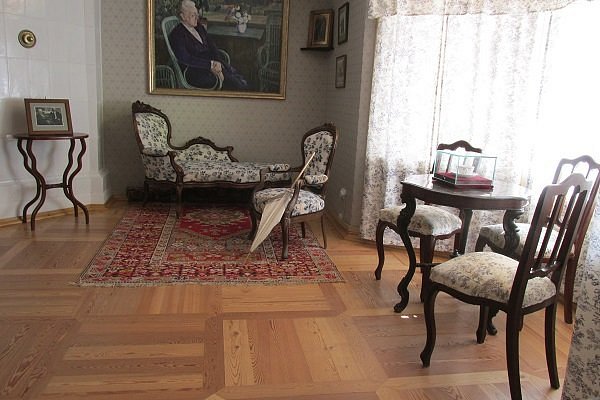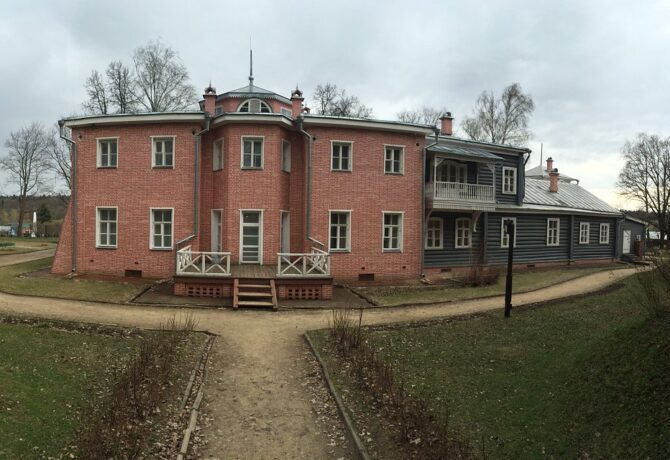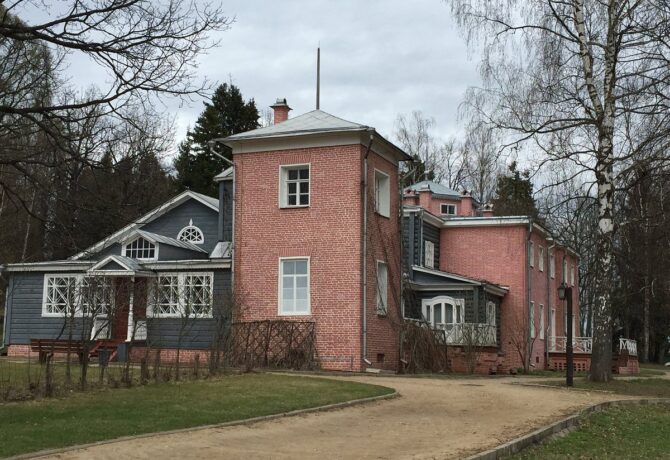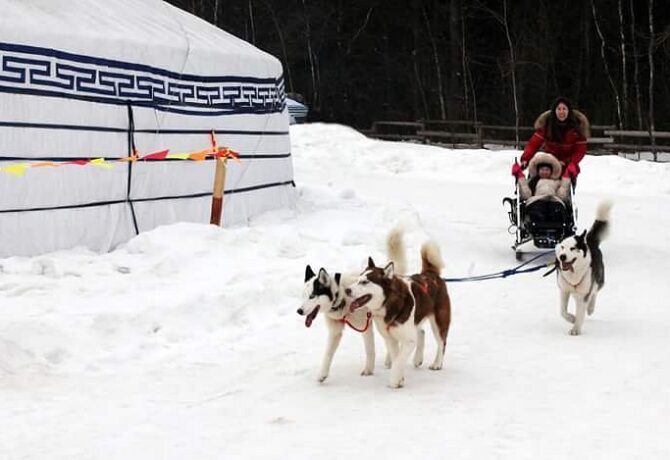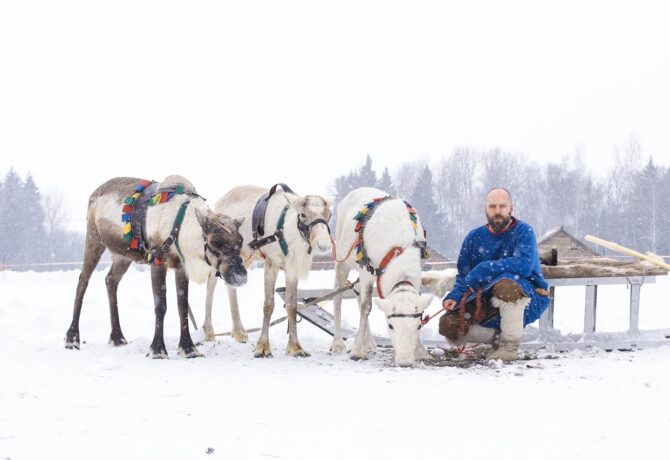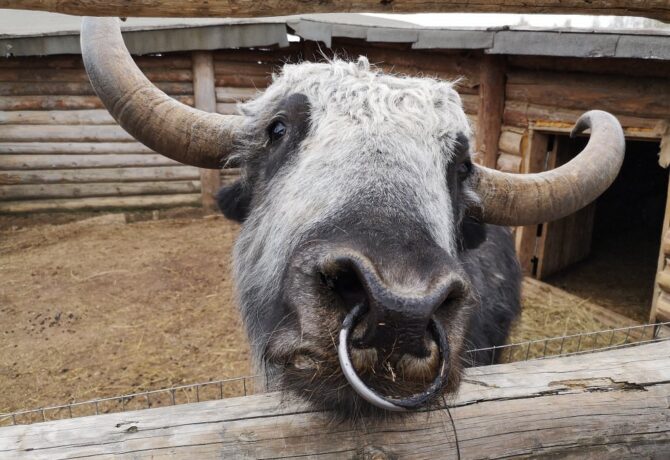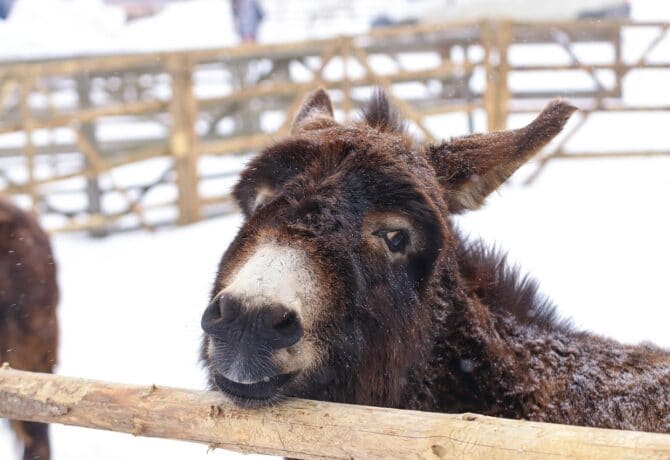Sergiev Posad became the first city near Moscow included in the tourist route “Golden Ring of Russia”. It was founded in 1337, when around the cell and a small temple, cut down by brothers-monks Sergius and Stephen in honor of the Holy Trinity, the monastery began to be rebuilt. Followers of Sergius of Radonezh served in it, and the Lavra itself eventually became the center of Russian Orthodoxy. Today Sergiev Posad is a place of pilgrimage for believers from all over the world. The Orthodox capital of the “Golden Ring” receives tens of thousands of tourists every day. The city has created an excellent infrastructure in the field of hospitality. Travelers are waiting for cozy hotels, museums and sights of the city. You can independently make a route for an excursion of one day, using the descriptions of interesting places of Sergiev Posad.
- 1 Observation deck “Pancake Mountain”
- 2 Trinity sergius Lavra
- 3 Trinity Cathedral
- 4 Church of St. Nikon of Radonezh
- 5 Dukhovskaya Church
- 6 Assumption Cathedral
- 7 Assumption chapel over the well
- 8 Water-holy chapel-sen
- 9 Tomb of godunovs
- 10 Sacristy of the Trinity-Sergius Lavra
- 11 Church of Zosima and Sabvatius
- 12 Predtechenskaya church
- 13 Refectory chambers
- 14 Mikheevskaya and Smolensk churches
- 15 Belfry of the monastery
- 16 Museum complex Horse Yard
- 17 Park “Skit ponds”
- 18 Gethsemane Chernihiv Skete
- 19 Spaso-Bethany Monastery
- 20 Source Gremyachy Key
- 21 Abramtsevo Manor
- 22 Muranovo Manor
- 23 Ethnopark Nomad
- 24 Attractions Sergiev Posad on map
Observation deck “Pancake Mountain”
The observation deck “Pancake Mountain” gives you the opportunity to explore the panorama of the city, admire the splendor of the Trinity-Sergius Lavra. The hill got its name not by chance. Before the revolution, there were the best taverns in which the famous Trinity pancakes were baked. Pilgrims were sure to climb here to have a snack after a long journey before bowing to the holy relics. Innkeepers sold alcohol, so worldly people returned here in the evening, but the clergy forbade monks to visit these noisy places. In Soviet times, the number of pilgrims decreased sharply. The pancakes closed. Their place was taken by the “flea market”. Only after the 90s, when Orthodoxy began to revive in the country, believers returned to the monastery and tourists began to come. Pancake Mountain was landscaped and made a platform for viewing the panorama and picturesque photo shoots. From the height of the hill you can see the monastery, and its multi-colored heads of churches visually fold into an interesting mosaic. The contrast to its white-stone walls is the green spaces on both banks of the Konchura River.
Address: Voznesenskaya Street, Sergiev Posad, Moscow Oblast, Russia
Trinity sergius Lavra
The Trinity Monastery was founded in 1337 by the especially revered Russian Saint Sergius of Radonezh. Today it is the largest educational and spiritual center of the Russian Orthodox Church. In the Middle Ages, the Lavra played a prominent role in the life of North-Eastern Russia. The brotherhood was a reliable support for the authorities and a faithful assistant for the people. This is evidenced by historical facts. The nooks Alexander Peresvet and Rodion Oslyabya became the heroes of the Battle of Kulikovo. The monks opposed the supporters of False Demetrius II and False Demetrius III. They opposed the rule of Semiboyarschina. In the Time of Troubles, the brotherhood entered the Second Militia in the fight against the Polish interventionists, before that the monks withstood a 16-month siege of their monastery. The monastery supported Peter I in the struggle for power against Princess Sophia. These and other heroic actions of the brotherhood will be told during a tour of the monastery.
After the revolution, the Lavra was closed, the monks were exiled to labor settlements or remote sketes. The entire territory was placed at the disposal of the Historical and Architectural Museum. Due to this, the ensemble of the monastery did not suffer much even at the time when the Zagorsk Pedagogical Institute existed on its territory (until 1953). A sad fate befell most of the bells of the Lavra. Almost all of them were sent for remelting. Miraculously survived “Swan” (1593 year of creation) and the oldest “Nikonovsky” (1420). Monastic life resumed in 1946, but the main restoration and restoration work began immediately after the final transfer of the monastery back to the ROC. The appearance of the Lavra was completely restored in its heyday.
Today, on the territory of the object, included in the UNESCO World Heritage List, you can visit the Holy Trinity Cathedral, eight restored churches, a bell tower, an overlamentary chapel. The Lavra houses Orthodox shrines – the relics of St. Sergius of Radonezh, Maximus the Greek and other saints. For pilgrims and travelers who want to spend a few days near the monastery, their services are offered by the hotels “Lavra” (102 m to the object), “Old Town” (155 m), shishkin guest house (160 m).
Address of the Trinity-Sergius Lavra: Sergiev Posad, Moscow Region, Russia
Trinity Cathedral
Acquaintance with the temples and buildings of the Trinity-Sergius Lavra can take a whole day. Trinity Cathedral is central to the monastery, and it usually begins a tour of the territory. The white-stone temple was erected in 1422-23 by a disciple of Sergius of Radonezh Nikon. Here is kept the main shrine of the Lavra – the relics of the monk founder of the monastery. For its painting and creation of the iconostasis, Russian icon painters Andrei Rublev and Daniil Cherny were invited. They created a special iconostasis – in it the icons are located in a continuous row without separation by altar pillars. The frescoes of that time have not been preserved. In 1635, the wall painting was recreated according to the originals of 1425-1427. The cathedral is active, it regularly holds services. The brethren of the monastery take monastic tonsure here.
Address: Krasnogorsk Square, Sergiev-Pasad, Moscow Region, Russia
Church of St. Nikon of Radonezh
After the death of the faithful disciple of St. Sergius of Radonezh Nikon, it was decided to erect a church in his honor. The monk, and then the abbot of the monastery, like his teacher, was canonized as An Orthodox saint. In 1548, a small stone church appeared above his grave. Only a piece of foundation has survived from it to this day. In 1623-24, a new stone church was built on this place, which, due to its proximity to the Trinity Cathedral, is considered its chapel. Cancer with holy relics rests at the northern wall. The Monk Nikon of Radonezh was the personification of patience. It is addressed in case of a situation, the resolution of which will require a large shutter speed.
Address: Holy Trinity Sergius Lavra, Sergiev-Pasad, Moscow Region, Russia
Dukhovskaya Church
This is the second stone church of the Trinity-Sergius Lavra, which was built on the site of the former wooden building of the Trinity Cathedral. It was built in 1476-1477. Ivanovo and European architects were invited for the construction, who, at the invitation of Vasily III, rebuilt Moscow. The masters were given the task to make a new church in the likeness of the Trinity Cathedral, but that it was different from it. As a result, the external stylistic similarity was observed with a completely different architectural idea. The Dukhovskaya church was called the “church of the same bells”, since the belfry was located on the vaults of the temple. The church-belfry is made of brick, unlike the white-stone Trinity Cathedral, plastered and painted white. The apses of the temple are decorated with decorative semi-columns with garlands. Metropolitan Platon (1737-1812 years of life) is buried in the church, who all his life tried to reconcile the champions of the new faith with the Old Believers.
Address: Vorobyovskaya St., 35, Sergiev-Pasad, Moscow Region, Russia
Assumption Cathedral
The five-domed majestic temple on the territory of the Trinity-Sergius Lavra was laid at the behest of Tsar John the Terrible in 1559. The laying of the first stone was attended by the monarch himself and his entire family. The cathedral was built until 1585. The lighting was carried out after the death of the tsar by Metropolitan Dionysius in the presence of the heir to the throne Fyodor Ioannovich and his wife Irina Feodorovna Godunova. The temple was created in the likeness of the Assumption Cathedral in the Moscow Kremlin. Two chapels were completed to it in honor of Fyodor Stratilat and the Great Martyr Irina. The third aisle appeared in 1610 after a 16-month siege of the monastery by the Polish interventionists. This chapel was consecrated in honor of Nicholas the Wonderworker. In the central room near the southern wall there is a wooden coffin, in which the relics of Sergius of Radonezh rested until 1585. Then they were transferred to a silver gilded crayfish, which was installed in the Trinity Cathedral. The walls and vaults of the Assumption Cathedral were painted in 1684 by a group of icon painters under the leadership of Dmitry Plekhanov. The frescoes were restored in the 40s of the twentieth century. Currently, the cathedral is active.
Address: Holy Trinity Sergius Lavra, Sergiev-Pasad, Moscow Region, Russia
Assumption chapel over the well
The Assumption storehouse was rebuilt in 1644 over a spring with healing water. The chapel appeared a little later. According to legend, the water was caused by the Monk Sergius of Radonezh himself, taking pity on his brothers-monks. The nearest source was at a decent distance, the abbots themselves asked the saint to help them solve the problem with water on the territory of the monastery. The superstructure chapel is located at the south-western corner of the Assumption Cathedral. Inside is a miraculous icon “Life-giving spring”.
Address: Holy Trinity Sergius Lavra, Sergiev-Pasad, Moscow Region, Russia
Water-holy chapel-sen
In another way, this attraction is called “Shadow over the cross”. This is an elegant tent, installed in 1872 above the pool for the consecration of water. It is located between the Nadkladeznaya Assumption Chapel and the Obelisk, installed on the Cathedral Square. In the center of the pool bowl there is a cross, from the horizontal bar of which water flows through the pipeline from a nearby source. This source was caused by Sergius of Radonezh himself, when the monastic brethren turned to him about their own well on the territory of the monastery.
Address: Red Army Sp., 127, korp. 6, Sergiev-Pasad, Moscow Region, Russia
Tomb of godunovs
To the left of the front porch of the Assumption Cathedral is a squat crypt. This is the tomb of Tsar Boris Godunov, his wife and son, as well as Princess Xenia, who took tonsure under the name of the nun Olga. The tomb was built at the behest of Vasily Shuisky. He wanted the memory of godunov’s innocently murdered family to remain in memory. Tsar Boris and his relatives were killed by supporters of False Demetrius I. Princess Xenia was sent to a monastery, where she was tonsured a nun, and after her death in 1622 was transferred to the tomb.
Address: Holy Trinity Sergius Lavra, Sergiev-Pasad, Moscow Region, Russia
Sacristy of the Trinity-Sergius Lavra
The sacristy refers to office space. The Sacristy provides divine services with the necessary books, icons, utensils, and also keeps books of accounting of the Lavra property. Today, a museum works in the premises of the sacristy. The collection consists of a collection of artistic values of the 14th-19th centuries. This is a clear history of the formation and flowering of Russian Orthodoxy on the example of the Trinity-Sergius Lavra. Among the exhibits are ancient books, handwritten chronicles, icons, gold and silver church accessories. Entrance fee. The ticket price is 500 – 300 rubles Entrance to the museum is to the right of the Trinity Cathedral.
Address: vl1k1, Holy Trinity Sergius Lavra, Sergiev-Pasad, Moscow Region, Russia
Church of Zosima and Sabvatius
To the Church of St. Zosima and Savvatiy Solovetsky is a path from the Trinity Cathedral to the Kalitch Gate. The church was built by the efforts of Kelar Alexander Bulatnikov in 1635-37. Kelar himself was a native of the Solovetsky Monastery. He came to the Trinity-Sergius Lavra to help the brothers restore the Trinity Cathedral and other buildings after a 16-month siege of the monastery by the Polish interventionists. For 20 years, he erected and repaired damaged buildings. It was he who proposed to build a hospital church on the territory of the monastery. It was consecrated in honor of the founders of the Solovetsky Monastery Zosima and Savvatiy. They pray when difficulties fall on people one after another, the saints help to cope with adversity, giving a person strength and faith.
Address: Holy Trinity Sergius Lavra, Sergiev-Pasad, Moscow Region, Russia
Predtechenskaya church
The gate church in honor of the Nativity of John the Baptist meets and sees off the guests of the Lavra. It is located above the main entrance to the monastery. It was built on the site of the dilapidated St. Sergius Church, and consecrated in 1699. This is a two-tiered structure with a height of 22 meters, crowned with golden-domed domes. The last wall paintings were carried out in the 19th century with oil paints. They depict popular biblical subjects. The building has preserved a 17th-century tiled stove. The iconostasis of 1872 was lost in 1919. When the monks returned to the monastery, they first restored the iconostasis, making it gilded and carved in the Empire style. Significant restoration of the temple was carried out in 1974-78. Full recovery lasted from 2006 to 2010.
On this first excursion day you can finish and return to your hotels. In Sergiev Posad there are hotels of different categories of comfort. The most comfortable are “Barskie Polati”, “Posadsky”, “Hotel Vladimirskaya”. The city itself is small, so the Trinity-Sergius Lavra is within walking distance from them.
Address: Holy Trinity Sergius Lavra, Sergiev-Pasad, Moscow Region, Russia
Refectory chambers
The next day after breakfast (all hotels include morning food in the price) it is worth returning to the territory of the Lavra to see other sights. The refectory church, founded in the late 17th century, is one of the most striking architectural monuments in the monastery. It was consecrated for the 300th anniversary of St. Sergius of Radonezh. In a spacious room with a fraternal refectory area of 500 square meters. m solemn feasts dedicated to Orthodox holidays are held. The wall painting was made in the 17th century. The temple was ordered to be built by the brothers John V and Peter I Alekseevich as a sign of gratitude to the monks of the monastery for the temporary shelter for the royal family during the Streletsky riot. The temple was consecrated in 1692 in the presence of royalty.
Address: 133, Red Army Gully, Sergiev-Pasad, Moscow Region, Russia
Mikheevskaya and Smolensk churches
The church in honor of St. Micah was built in 1734 by order of Empress Anna Ioannovna. Two years earlier, Archimandrite Varlaam appealed to the Supreme Synod to allow the erection of this temple. Mikheevskaya Church is the smallest in size on the territory of the Lavra. It is installed over the grave of St. Micah, to whom the monks “sing prayers, always read the troparion and kondak.” Inside there is an iconostasis of the 18th century from the house church of Metropolitan Platon (Levshin). The wall painting was made in the 19th century. The temple is located at the north-western corner of the Refectory Chambers.
Opposite the Church of St. Zosima and Savvatiy, the Smolensk Church of the Icon of the Mother of God Odigitria was built. It was built from 1746 to 1753. The miraculous stone icon itself is in the sacristy museum, and its exact copy is installed on the facade of the temple. Funds for the construction of the temple were donated by Count Razumovsky. Earlier on this place there was a cookhouse, the building of which was dilapidated and was dismantled. Empress Elizabeth Petrovna and her court retinue came to the grand opening.
Address: Holy Trinity Sergius Lavra, Sergiev-Pasad, Moscow Region, Russia
Belfry of the monastery
Then the path will pass to the north to the monastery bell tower. It was built in the northern part of the cathedral square of the Lavra and closes its architectural ensemble. The belfry was built from 1741 to 1770. The height of the structure is 88 meters. The bell tower consists of a lower two-tiered base with four tiers of ringing extending upwards. In 1784, the famous Tula master Ivan Kobylin created a tower clock with chimes. The movement worked properly for 120 years and was replaced by a new one only in 1905. At different times, the number of bells ranged from 42 to 50 pieces. Many of them suffered a sad fate. During the years of Soviet power, most of them were sent for remelting. Only small bells were left for the museum exposition. In 1999-2000, a complete reconstruction of the belfry was carried out. Three evangelist bells were re-cast, including the Tsar Bell.
Address: Holy Trinity Sergius Lavra, Sergiev-Pasad, Moscow Region, Russia
Museum complex Horse Yard
After visiting the main Orthodox attraction of Sergiev Posad, the Trinity-Sergius Lavra, it is worth paying attention to the objects of the state Sergiev Posad Museum-Reserve. One of its branches is the Horse Yard. It is located on the picturesque shore of the White Pond. Year of foundation 1790. It contained the stable farm of the Lavra – 700 horses. After the revolution, all buildings were nationalized, distributed to various organizations, over time, the buildings began to collapse. The first to sound the alarm was the historical and art museum-reserve. Through the efforts of its management and employees on the territory of the Horse Yard, restoration began. The monks of the monastery joined the restoration work. Today, the museum complex has permanent exhibitions dedicated to the Russian nesting doll, rural life, decorative and applied art and the art of Palekh. In the exhibition halls, excursions are held on the history of the Lavra and the ancient past of the territory of Sergiev Posad. Tickets from 60 to 500 rub.
Address: 2, 1st Shock Army St., Sergiev Posad, Moscow Region, Russia
Park “Skit ponds”
In the south-eastern part of Sergiev Posad there is a landscaped cozy park “Skitskie Prudy”. In the 19th century, the monks began to build their own wooden and underground sketes here, hence the name. The ponds are of artificial origin. In the 17th century, they began to equip the monastery kelar Ershov. Reservoirs were used to breed fish to the refectory table. Even in Soviet times, mirror carp were bred here. But due to improper care, the ponds became shallow, the banks were overgrown. In the 2000s, it was decided to revive the reservoirs and equip the parks on the banks. Today the park is a favorite vacation spot of citizens and guests of Sergiev Posad. In winter, an ice rink is flooded on its territory, and entertainment events are held at any time of the year.
Address: Vifanskaya str., vl. 151, Sergiev-Pasad, Moscow Region, Russia
Gethsemane Chernihiv Skete
Near the park “Skit ponds” is gethsemane Chernigov skete. It was founded in 1843-44. A year later, the first wooden cell of monks appeared, who were looking for solitude. In 1847, the blessed monk Filippushka mastered the underground department. Over time, the monastics began to independently build for themselves sketes in the Isakov grove. They dug dugouts or made small wooden buildings. Picturesque nature and silence attracted the nuns with their tranquility and silence. The skete became a haven for 400 monks. After the revolution, it was closed, desecrated and looted. Restoration work began in 1990. Today the hermitage is a place of pilgrimage and the object of a tourist excursion. Attractions include underground temples, cellies and a holy spring.
Address: 1 Gethsemane Ponds St., Sergiev Posad, Moscow Region, Russia
Spaso-Bethany Monastery
The male Orthodox monastery was founded on the site of the Skete of Bethany in 1797. Archbishop Platon (Levshin) began to rebuild it in 1783. The monastery received its name in honor of the city in the Holy Land, where Jesus Christ revived the righteous Lazarus. Bethany is interesting not only for pilgrims, but also for tourists interested in architecture. In the center of the monastery is the Transfiguration Cathedral. This is a two-tiered temple, built by an “oval figure” in the image of early Christian churches like st. Sophia Cathedral in Constantinople. The interior decoration included an artificial cave, in which, according to legend, Lazarus was buried. An altar was set up at the top of the mountain. Today, the interior decoration is fully restored to the previous standards. The temple is active.
Address: 25, Maslieva St., Sergiev Posad, Moscow Region, Russia
No less interesting are the surroundings of Sergiev Posad. You can get to them by car, public transport or book a transfer at your hotel.
Source Gremyachy Key
The spring of St. Sergius of Radonezh is located 28 km from the Trinity-Sergius Lavra. A concrete road is laid to it, so you can safely go on your own. Public transport is not available. There is a bus number 120, it comes from the bus station. It provides access to the station “Malinniki”. Then you will have to walk another 4 km. afoot. There is a rubble car park in front of the property. At the source you can collect water, plunge into a large font, stand under the stream in one of the four booths. Next to the locker rooms (men’s and women’s). There is a refectory where you can have a snack with traditional monastic food. On the territory of the Gremyachy Key, monks breed chickens, quails and goats, so in eco-shops you can buy the products of this household farm. Proceeds from the sale of meat, eggs, refectory dishes, as well as all donations go to the maintenance of the source, utility bills, repair work.
There is a legend about how the source appeared. Once Sergius of Radonezh and his student Roman Kirzhachsky went on a journey. Their path passed along the Kirzhach River. After walking many kilometers, they stopped to rest. It was summer, it was hot weather. There were plenty of berries in the forest, but on the way they did not meet a single drinking spring. Then Roman asked Sergius to pray before God and give them water. Sergius of Radonezh said a prayer, struck the ground with a staff, and from the ground scored a clean spring spring. From the Lavra to the Gremyachy spring, a walking route was laid, along which the monk walked with his disciple. The length is 15 km.
Address: Gremyachy Klyuch tract near the village of Vzglyadnevo, Sergiev Posad, Moscow Region, Russia
Abramtsevo Manor
Historical, Art and Literary Museum-Reserve “Abramtsevo” is located 24 km (by highway) from Sergiev Posad. Since 18 43 years, the estate belonged to the famous Russian writer Sergei Timofeevich Aksakov. This house for several decades was the center of literary life. The owner arranged “Abramtsevo Saturdays”, to which Gogol, Turgenev, Shevelev and other writers came. It was here that Nikolai Vasilyevich Gogol read chapters from the 2nd volume of Dead Souls. In 1870, the estate was bought by the industrialist and famous philanthropist Savva Ivanovich Mamontov. Artists Vasnetsov, Vrubel, Repin, Levitan and others began to come here and work. In Abramtsevo often visited Chaliapin, Shchepkin, famous musicians and actors.
After the revolution, the property was nationalized, but a museum was organized on the territory almost immediately. His first keeper was Mamontov’s daughter Alexandra Savvichna. Today you can visit the central house, workshop, former medical building, Polenovskaya dacha, bath-tower, see unique man-made sculptures. A single ticket costs 500 rubles To the railway station Khotkovo should be a train. Next, you need to change to the minibus 55 and get to Abramtsevo.
Address: 1 Museumnaya St., Abramtsevo village, Sergiev Posad, Moscow Region, Russia
Muranovo Manor
The literary-memorial museum, created by the descendants of Tyutchev, is located from Sergiev Posad at a distance of 29 km along the highway. It was founded in 1920 on the territory of the estate Muranovo. It became the first literary museum created in the young Soviet republic (“Yasnaya Polyana” opened a year later). The poet’s family lived in the estate since 1870. Here the entire archive of Tyutchev was stored. The main buildings were erected when the estate belonged to the poet Baratynsky. After the unsuccessful uprising of the Decembrists, he retired from society and began to engage in farming. In 30-40 years he built a house, a mill, a sawmill, updated the forest belt. In the backyard house there is an exposition. The tour includes a visit to the writer’s office, library, dining room, literary salon and other rooms intended for personal use. You can get there by train to the station “Akuninskaya”, then change to bus 34, get to the stop “Muranovo Museum”.
Address: Muranovo village, Ashukino village, Sergiev Posad, Moscow region, Russia
Ethnopark Nomad
You can get to the unique open-air museum by train to the Khotkovo station. Then take a taxi. If you drive your car along the Yaroslavl highway, then already in the area of Khotkovo and Abramtsevo plagues, yurts and camels will be visible. Here you can spend the whole day and even stay overnight. A camel farm, excursions to the animals living on the territory, dishes of national cuisines of nomadic peoples are offered to the attention of guests. Folk festivals are regularly held here. The entrance fee includes a rich excursion program and master classes. Hotels are not provided here. Guests can camp and rent a yurt.
Address: surroundings of Khotkovo village, Sergiev Posad, Moscow region, Russia

